#jabiru the aborigine
Text
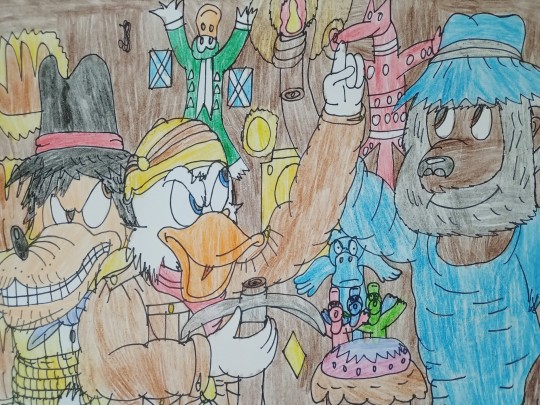
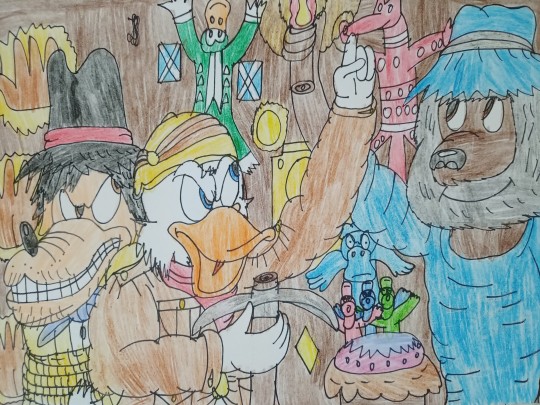


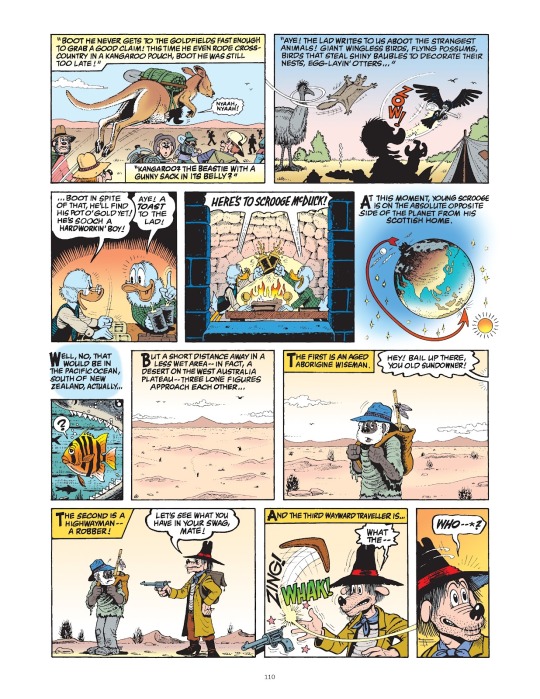
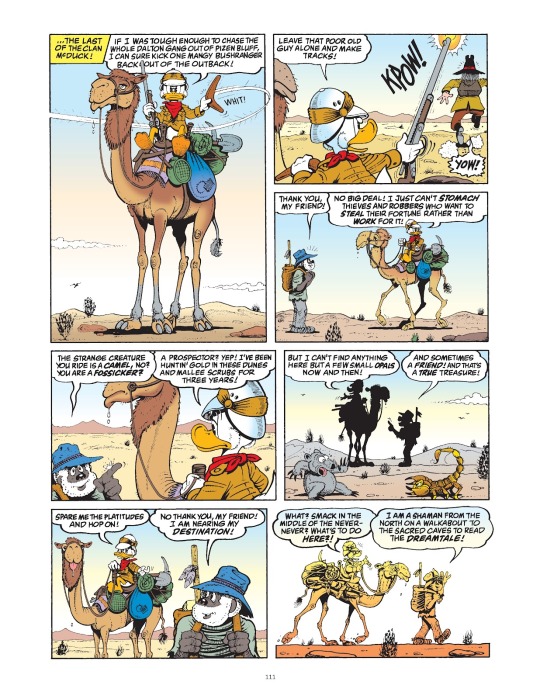




Scrooge McDuck in Australia in search of a shiny crocodile egg - The Life and Times of Scrooge McDuck - Donald Duck and Joey the Kangaroo - Daddy Duck - Australia Day - Duckverse
Yes, I am late, because Australia Day is celebrated on the 26th of January, but for some reason I didn't get to finish it until now. However, since I'm currently in the spirit of Australia, I'm going to publish some drawings of our heroes related to that country.
By the way, Australia Day is celebrated because on that day, in 1788, the first fleet made landfall and raised the British flag under the command of Arthur Phillip and founded Sydney there. Admittedly, the first settlers were prisoners.
The first drawing I drew was related to The Life and Times of Scrooge McDuck and the comic "The Dreamtime Duck of the Never-Never", which was the seventh part of the cult album by Don Rosa and tells about Scrooge's trip to Australia and his many misadventures . Scrooge met the highwayman and saved the aborigine from that highwayman. That aborigine is called Jabiru the aborigine and he is a representative of the indigenous people who lived in Australia. Scrooge found a brilliantly decorated egg that was worth a fortune, yet hearing from Jabiru the dream stories, otherwise known as Dreamtales, which were painted in the cave, he gave up on it and moved on in search of greater riches. I drew Scrooge, Jabiru, and a bound highwayman in a cave that was painted with various images that foretell Scrooge's future (you can see the Money Bin and Scrooge's future family members Donald and Huey, Dewey, and Louie). By the way, I used painting motifs as used by Aboriginal people and as used by Don Rosa in his comics, but I combined them in my own ways. Yes, and music related to these drawings: https://www.youtube.com/watch?v=KLVPgNjQ5kg
The second drawing is a redraw from the Donald Duck classic short "Daddy Duck" from 1948, directed by Jack Hannah, where Donald adopts a baby kangaroo named Joey the Kangaroo. Although mischievous, that kangaroo still loved his adoptive father Donald, as he loved him, and in my opinion it is one of the few moments (at least as far as Jack Hannah is concerned) where Donald finally had a happy ending. Yes, I drew it, because after all, kangaroos live in Australia.
I hope you like these drawings and these ideas and feel free to like and reblog this! And happy belated Australia Day!
#my fanarts#australia day#australia#duckverse#duck comics#donald duck#scrooge mcduck#ducktales#the life and times of scrooge mcduck#don rosa#artists on tumblr#classic shorts#joey the kangaroo#disney ducks#jabiru the aborigine#highwayman#dreamtime#disney dogs#disney duckverse#disney cartoons#cartoons#comics#cartoon#don rosa comics#disney duck comics#my fanart#fanarts#fanart#my style#disney kangaroo
23 notes
·
View notes
Text
Choosing The Right Guided Tour For Your Kakadu Adventure

Choosing the right guided tours of Kakadu can be a big decision. The right one will help you make the most of your time in Kakadu National Park and get you closest to nature without having to deal with all the hassle of planning a trip yourself.
What are the most popular Kakadu tours?
The most popular tours are the 4WD and boat tours. The destinations are Nitmiluk National Park and Nourlangie Rock, which offer swimming, hiking, and fishing opportunities.
Of course there are many other options for you to choose from in Kakadu National Park!
For more information our Visit Website: https://www.inspiringvacations.com/au/kakadu-tours/
Kakadu National Park is located in the Northern Territory of Australia, north of Alice Springs and east of Darwin. The park covers an area of approximately 20,000 square kilometres (7,704 sq mi), making it one of the largest national parks in the world.
The park is well known for its exceptional wildlife and vegetation, as well as for its ancient Aboriginal rock art. Kakadu contains a wide variety of habitats including wetlands, riparian forests, open savannah woodland and grasslands.
Where can I go on my Kakadu tour?
There are many tour options to choose from. You can go on a Kakadu National Park tour or a Nitmiluk National Park tour, which is also called Katherine Gorge. You can also visit Litchfield National Park and Prince Regent National Park.
The best way to decide what type of tour you want is by considering what kind of experience you're looking for and how long you'll be staying in Australia. If this is your first time traveling abroad, then we recommend starting with one of our short trips that only last 3 days or so; these tours will give you an introduction into what it's like to travel internationally while giving your body time adjust before venturing out further into the country (or even continent).
Our most popular option for first-time visitors is our 4-day Kakadu Adventure package--this includes all transportation between destinations as well as lodging at either Kings Canyon Lodge & Resort or Jabiru Gardens Hotel & Spa within Kakadu National Park itself!
What should I expect from a Kakadu tour?
Kakadu is a land of incredible beauty and diversity, with a wealth of wildlife, landscapes and history to explore.
If you're planning on taking a guided tour around Kakadu National Park, here's what to expect:
Weather - The weather in Kakadu can be unpredictable at times; it can change from hot and sunny one minute to rainy and cool the next! Make sure your tour includes rain gear so that you're prepared for any eventuality. It's also important that your tour includes air-conditioned vehicles so that when things get too hot or cold inside them (or both), they have somewhere cool to go where they can rest while waiting out their bad luck streak.
Wildlife - There are many species of animals living within Kakadu National Park including crocodiles, kangaroos and dingoes but also some less common creatures such as snakes or lizards which may not always be visible depending on whether they've been disturbed recently by humans entering their habitat area too closely without being aware what might happen after doing so.
Conclusion
Kakadu is one of the most spectacular places on earth and offers a range of activities for everyone. Whether you're looking for something adventurous or relaxing, we can help you find the right guided tours of Kakadu to suit your needs.
Source Url: https://guidedtourpackages.blogspot.com/2023/05/choosing-right-guided-tour-for-your.html
0 notes
Photo

2020 will be a good year. 👍 Looking forward to High Ground 👏👏👏 Thx @allriggedout 😘😘😘 Source: http://playtime.group/Film.aspx?ID=179889 #SimonBaker #HighGround #HighGroundFilm #HighGroundmovie #TheHighGround #Travis #callanmulvey #jackthompson #Action #Thriller #aboriginals #indigenous #arnhemland #kakadu #kakadunationalpark #madeinaustralia #northerntheretory #jabiru #bountyhunter #australia #movie #film #excited #mustache #screenaustralia https://www.instagram.com/p/B6MYInpqRfP/?igshid=128g4dgs3ifpx
#simonbaker#highground#highgroundfilm#highgroundmovie#thehighground#travis#callanmulvey#jackthompson#action#thriller#aboriginals#indigenous#arnhemland#kakadu#kakadunationalpark#madeinaustralia#northerntheretory#jabiru#bountyhunter#australia#movie#film#excited#mustache#screenaustralia
3 notes
·
View notes
Text
The Life and Times of Scrooge McDuck Retrospective: The Dreamtime Duck of the Never-Never! or You’d Better Run, You’d Better Take Cover

Welcome back all you happy people to my ongoing look at Don Rosa’s character defining masterpiece, the Life and Times of Scrooge McDuck! And for the next three months we’re doubling up as we race to the finish of this masterpiece! Well of the main story anyway, I do intend to cover the side chapters Rosa did after this as well as the utterly heartbreaking and heartwarming epilogue’s “A Letter From Home” and “Dream of a Lifetime” at some point, especailly since the latter not only is one of my faviorite single issue comic book stories EVER, but feels like the coda this series needed. It’s not NECESSARY to the main 12 chapter story arc, but it just makes everything sing that much more.
Anyways while I have kept a steadier past the past few chapters after taking a few months off, the last one DID slip, as I switched it with another review I was planning since, while not the HARDEST review, it was still a bit more intenstive than I had time for in the lead up to my vacation. So your getting it now as I formally return from my vacatoin.. after three reviews and three quick thoughts. I”m nothing if not timely.
So last time we got the origin of Flintheart Glomgold and as scrooge put it...

Which is understandable given Glomgold buddied up to scrooge.. then stole all his shit and left him in the wild for dead, leaving us with the bitter old bastard we know today.. in his mid 20′s no less. So after RIDING A MOTHERFUCKING LION and tar and feathering his new enemy, Scrooge left to go find gold elsewhere. And that’s where we pick up today, so join me under the cut as Scrooge picks up one final mentor before meeting his destiny.
So we open with the usual scrapbook page and with Angus and Jake in the castle. Four years have passed since the last story and Scrooge hasn’t found his fourtune stll: he found some bandits in Pizen Bluff, a story that Rosa INTENDED to be part of the main arc but decided against to avoid too many cowboy stories so it ended up as one of our side stories instead, and some small nuggets but hasn’t hit it rich. He has however sent back more than enough to pay for the castle’s taxes. So he has a knapsack of jack after taxes, but his family is comfy. So he’s made his way to a land down under where women glow and men plunder...

And thus the two toast the boy confident he’ll find his fortune. Meanwhile...

I love that bit. Anyway these three figures are an aged Indeginous Aboriginal Wiseman (The story calls him an Aborigine, but given that’s a loaded term in australia and was heavily used with colonial racism and genocide we’re not going with that. ) .. and an asshole who naturally plans to rob the poor old man.. who just as naturally gets his gun swiped by our hero's boomerang and is told to scatter. Scrooge is as said now gruff and bitter.. but still won’t stand for someone trying to steal what they haven’t earned from someone innocent. He may be a far harder man, phrasing, than he was when he first started out and he’s only to get colder and bitterer.. but he’s a good man at his core. You just have to dig a bit to find it.
Anyways the kindly old man we later learned is named Jabiru is on a walkabout, a spirtual journey done to reconnect the Aboriginal People with their culture and with nature itself.
Rosa choose to have an Aboriginal Shaman be Scrooge’s guide as they have a deep respect and knowledge of their own history, and thus Scrooge’s own respect for history and love for researching and discovering it is something he could learn here. I did not admitely do deep enough research to see what, if any mistakes Rosa makes or what white dumbassery is no doubt on display in some parts, I do at the very least get this comes from a place of love: he generally respects Austrlia’s ingenious peoples and their truly beauitful and treasured culture and history and simply wanted to show it to people: to give them a love and respect for a culture that most kids or even adults reading this probably woudln’t think about.
So Jabiru and Scrooge eventually stop seemingly in the middle of nowhere, as the Wiseman has found one of the spots he’s gone to and since he could find something seemingly nonexistant in the desert and knows the area better, Scrooge decides to learn from the guy to see if he can learn anything about finding gold.
So then Scrooge McDuck blows a digareedoo. I’m not making this up, that’s just a sentence you only get to type once in your life and i’m going to type it. THis also leads to Jabiru calling him “Jonflip” after Scrooge makes a joke about John Phillip sousa. Scrooge’s blowing though opens the way to an ancient cave, which only opens at just the right time, which the man knew due to simply knowing his history and culture. Scrooge is more helpful than blowing on a woodwind and has rope, with the man considering it fate as he woudln’t of been able to go down the hole otherwise.
Jabiru explains about Dreamtime, the aboriginal belief that all of man is connected via it’s history, as well as all of nature itself, and in a really amazing moment Scrooge finds thousands of handprints, all daiting back over 20,000 years. They find what seems to be a prophecy about a platypus returning an egg, and a giant opal which ahs been there since “Dreamtime itself” .. which Scrooge naturally wants to buy becuase fuck history.
They soon have bigger issues though as the asshole from earlier shows up, takes their rope and wants the opal to get it back. Jabiru trusts him... but Scrooge’s paranoia is right as the asshole leaves them and throws the rope all the way down.
Thankfully this is Scrooge we’re talking about so he naturally calls an emu...

And Scrooge uses it to catch up to the asshole while Jabiru continues on but hopes Scrooge will return the opal. Scrooge naturally easily dispatches the guy and recliams his stuff minus his gear.. but both get caught in a STAMPEDE OF KANGAROOS!... seriously you just.. only get to write some things once.
Things soon get worse for our hero as the asshole ends up leaving on teh pankcing camel and Scrooge is confused as to what CAUSED the stampede.. only to get caught in a FLASH FLOOD.

So Scrooge takes run and takes cover in the dreamtime cave as everything is swept away and Scrooge is seemingly lost.. halfway through the series. Riiiighhhtttttt. Naturally he surivived and it was easy enough to dig out the wet sand to climb.. but he’s still left with one last dilemma before he goes....

This is far and away both one of Life and Times best scenes and one of it’s most iconic: Despite his greed, despite how bitter he’s become, despite everything.. Scrooge can’t bring himself to break his moral code. Despite the fact no one else would know, despite the fact he’d get rich despite the fact tha tfrom his colonalist persepctive no one is using it.. he can’t take something he didn’t earn, that’s not his and that belongs to a rich cultural tapestry. Granted as we’ll soon see morals like that can sadly errode with time and someone can become the very thing they hated.. but for now in his darkest moment, where no one else would notice, in the deep dark of that cave.. Scrooge made the right decision. It’s what keeps him likeable despite the employee explotation and general dickery: deep down he is a good man.. just a very flawed one.
Turns out though those cave paintings were writing the future.. as such Jabiru is waiting for Scrooge and hleps the man find his dime, knowing all that would happen. I genuinely don’t know enough about Aborginial culture to tell if propcheisscing is a thing so i’m not really going to rag Rosa for this or the accidental use of the magical black man trope. Scrooge finds his dime.. and looks into the tapestry himself finding a drapery of lights... which he recognizes as the northern lights. So Scrooge is happy, thanking his new friend as he heads off for the great white north while Jabiru ponders some other figures... a giant golden egg, a blue platapus,, and three smaller ones in red, blue and green...
Final Thoughts:
This one is decent. It’s obvious Rosa was passionate about Aboriginal cutlure and wanted to share it and the magical elemmnts of a propechy do fit in this world.. it jsut feels a bit OOF to apply that to a still existing culture that has faced out and out genocide and continues to face systemic racisim and opression, like.. he means well but still shot himself in the foot.
So while that aspect is ...

The rest of the story is decent.. not as rich in character moments as other instalments and thus sadly a tad weaker as a result, but still a good ride and a necessary part of the story. It’s real issue is that i’ts sandwitched between two of the best chapters in the piece, so that comibined with the well intentoioned accidental racisim it just comes off a bit flat. NOt terrible but there’s better to come.
Next Time: It’s TIME. After years of strife and hard work to come up empty handed Scrooge FINALLY meets his destiny int he Klondike.. but first he has to deal with some shifty assholes, a certain familliar dance hall girl, and a frozen wooly mammoth
If you enjoyed this review and want more delcious content from me, sink your teeth into my patreon RIGHT HERE. For one dollar a month you get acess to exclusive reviews, including one where scrooge runs into some wig based legal trouble.. yes really. And it was written by carl barks no less. And your one dollar contirbution helps contribue to my MEMBERSHIP DRIVE. That’s right i’m currently having a drive so your contirbution will also unlock reivews for ALL READERS of the first seasons of Tuca and Bertie, the Great North and Amphibia, as well as Tuca and Bertie season 2. All that right now, for a buck, along with bonus reviews only you and anyone else who signs up can read and plenty of other unlock goals along the way. So sign up today and i’ll see you at the next rainbow!
#the life and times of scrooge mcduck#scrooge mcduck#don rosa#australia#aboriginal#the dreamtime duck of the never never#dreamtime#outback#walkabout#ducktales#disney#fantagraphics
22 notes
·
View notes
Text
Once a jolly swagman camped by a billabong....
After dropping the Chrises at Sydney Departures to catch their flight back to the UK (see previous blog post for part 1!), I headed onwards to the Domestic terminal to catch a flight up to Darwin. Arriving at 1am, I had a rather sleepless few hours on the floor of Darwin airport before greeting my parents through arrivals at 5am! We had 3 weeks of Outback adventures ahead to catch up on all we’d missed from a year apart!
We picked up our Britz campervan for the first part of the trip and headed straight in the direction of Kakadu National Park on the red dirt roads in the very hot sunshine to get straight into holiday mode! The evening was spent at an old aboriginal site called Ubirr; here there were ancient ochre paintings, beautiful rock formations and stunning vistas, perfect for a sunset viewing!

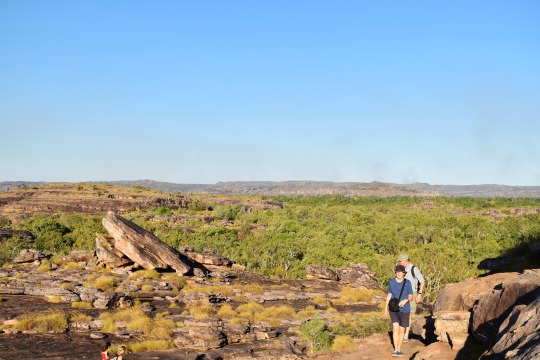
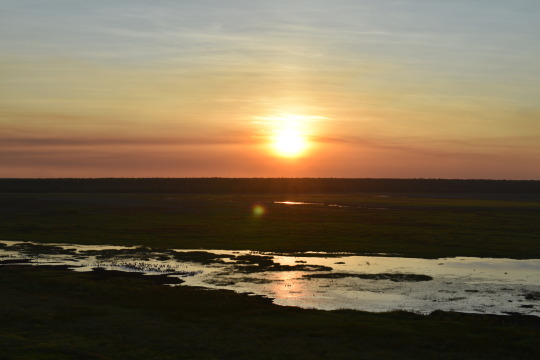
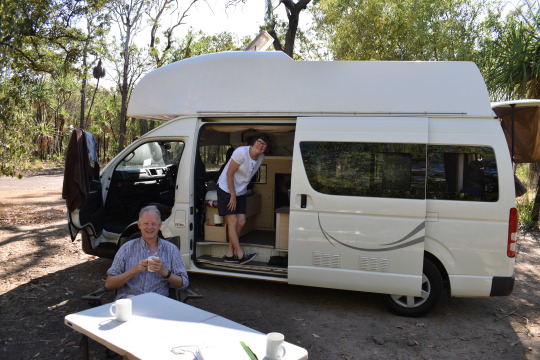
We’d heard there might be a possibility of seeing crocs in Kakadu although none of us were convinced we actually would. However, a stroll to Cahill’s Crossing proved us all wrong; on arrival we could see the ominous backs of about 12 crocodiles swimming around in the inaccurately named ‘East Alligator River’. There were locals fishing in the river standing scarily close to the edge, given that behind them were multiple collections of flowers and crosses commemorating people who had been killed in recent years by getting just that bit too close! It was incredible to see the crocodiles climbing out of the water and watching their size triple from what it had appeared in the water!
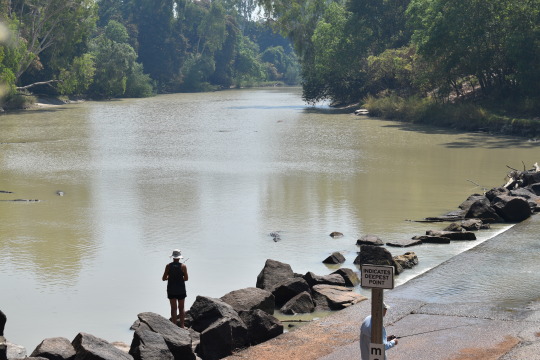
All those black dots in the water? Crocodiles!


A stunning walk around Bardedjilidgi sandstone outcrops and a steep hike up to Nawlandja lookout overlooking the Nourlangie escarpment provided some of our first exposures to the incredible Kakadu landscape! Given how much land was burning all the time (at one point there were embers right up to the road we were driving along), we were surprised at how green the landscape was.
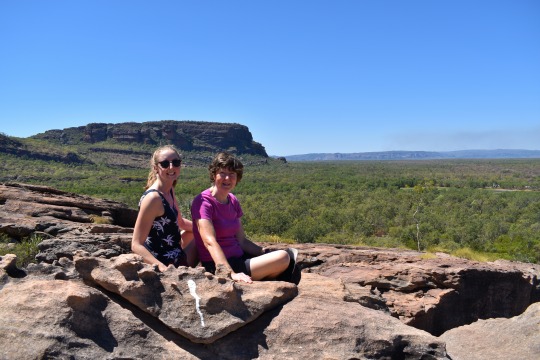

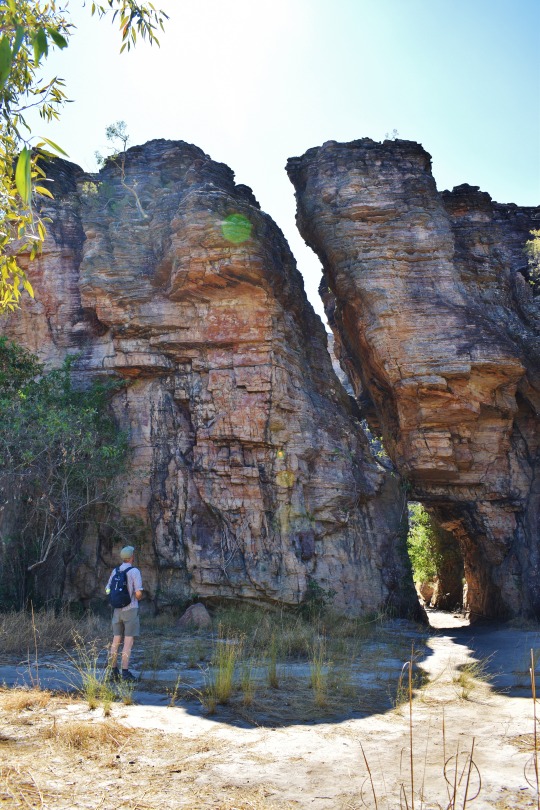
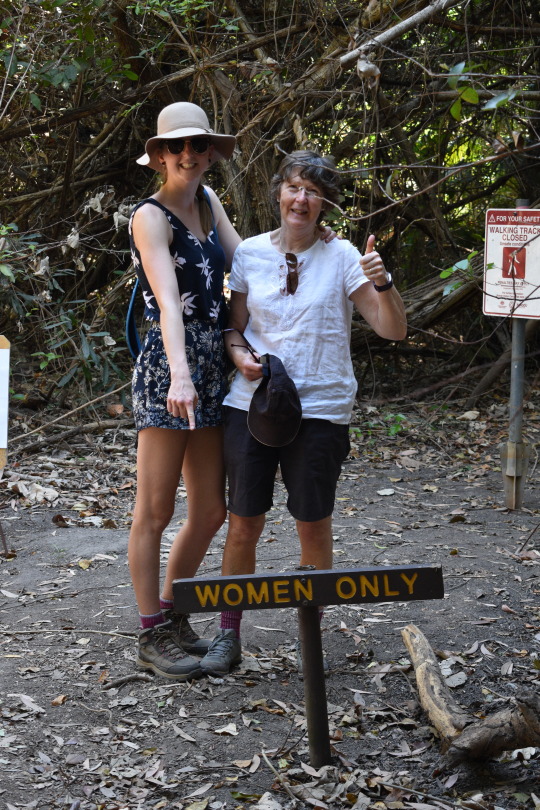
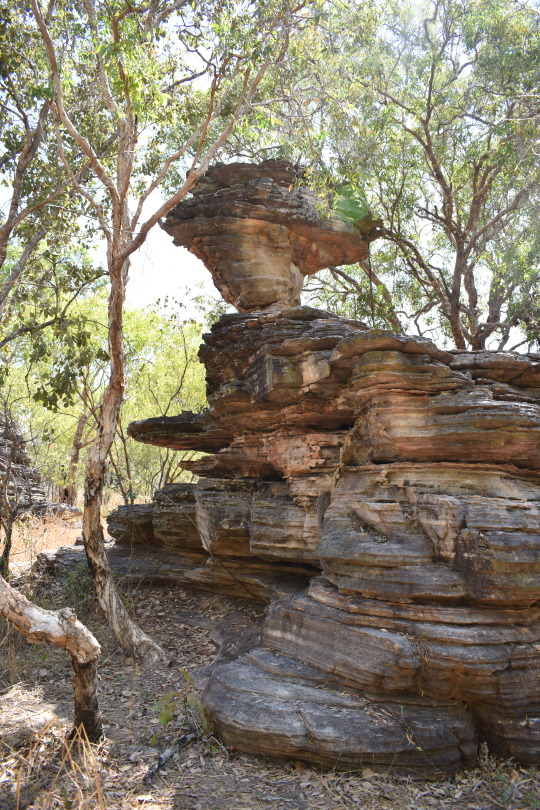
We braved another close croc encounter on a walk around Anbangbang billabong and also spotted our first Jabiru! It looked absolutely enormous – especially in comparison to all the other birds on the billabong!


Spent the night at an unexpectedly beautiful campsite on the Mary River where we were surrounded by wallabies and kangaroos!
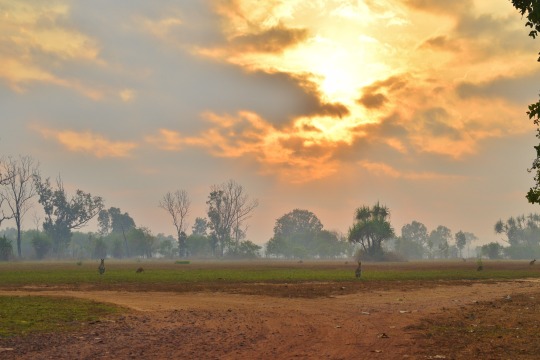
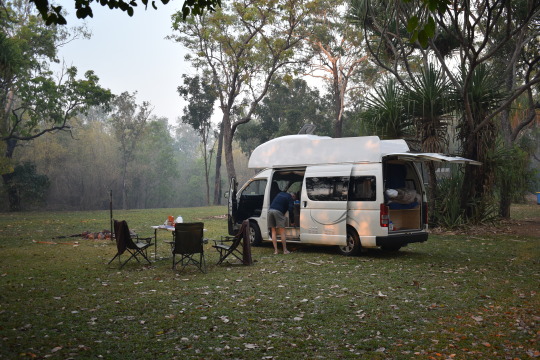
It was time to head across to Litchfield National Park – a smaller area and surprisingly quite different landscape to Kakadu given its relative proximity. We stopped off en route at the ‘magnetic termite mounds’ – so called as they are aligned with their main axis running north to south and orientated such to minimise midday sun exposure and warmth inside the mound. There were also some enormous mounds- up to 5 metres high!
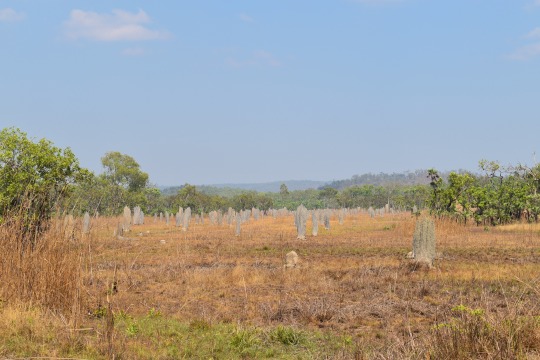

We did a walk to Buley rockholes (which themselves were full of people swimming) but we found our own private one just a few minutes downstream to have a much-needed refreshing dip! Our walk took us down to the popular Florence Falls, and then onwards to the stunning Wangi Falls where we were staying the night! Wangi falls had been closed until the week prior due to crocodile sightings so it was safe to say my mum did not look one bit relaxed for the beautiful sunset swim in there!
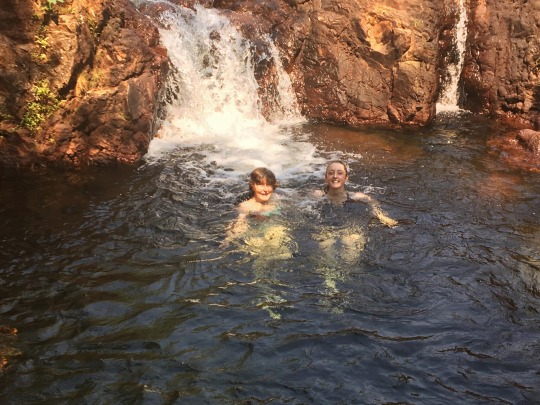
Buley Rockholes
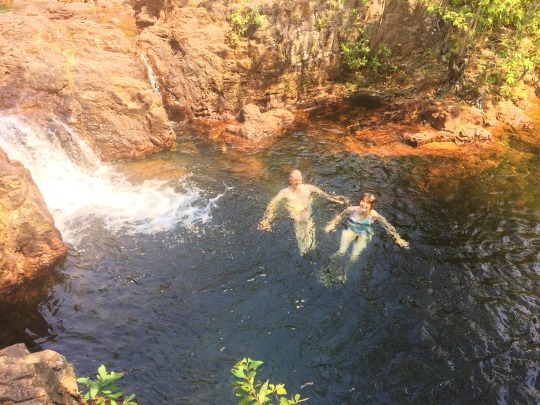

Wangi Falls
We squeezed as many hikes as we could in our short time in Litchfield so our last full day there was spent hiking along the Upper and Lower Cascades (literally clambering down a waterfall). It was so hot and we found an inviting rockhole mid-hike but had left our swimmers in the van– my dad and I are not ones to miss out on a plunge pool swimming opportunity so we just jumped in in our clothes! Lunch was at the top of yet another waterfall amid the Tjaetaba walk through a sharp contrast of monsoon forest and savanna landscapes! We finished the day with a walk around the Tolmer falls which were worth our close shave with heat stroke in the high temperatures of the afternoon!
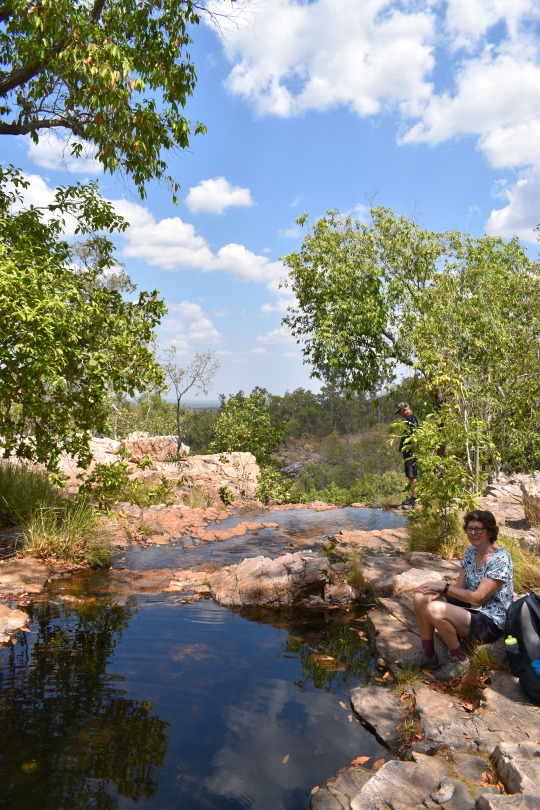

We briefly explored Darwin town centre and harbour before driving to the airport for our flight to Alice Springs for our Red Centre adventure!
Flying in we could see no evidence of any human life anywhere close until we got off the plane and saw there was in fact an airport there! It had just been expanses of red dirt as far as the eye could see, with no town in sight! We were staying in an amazing ‘glamping hut’ I found on Airbnb called Under The Hump. Sitting outside by the firepit having our kanga steaks with a beautiful view of the stars will certainly be one of me lasting memories of Alice! We weren’t quite prepared for the cold weather we would be faced with though – going from 32 degree mornings to 3 degrees was a bit of a shock to the system!

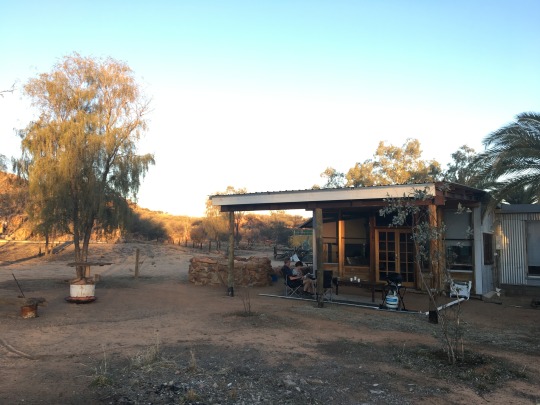
We explored the town and rather fell in love with its character! A small sleepy town surrounded thousands of miles of desert! Having lived by the coast all our life we realised it was the furthest any of us had ever been from the sea!
We explored the famous Todd Mall markets, and went to the Todd River (I was hugely disappointed by this as was expecting an actual river and was met by an expanse of sand. Apparently I was the only one to not be aware that this would be the case. My Tripadvisor review would be a generous 1star as far as rivers go. Same goes for the actual Alice Spring which I didn’t realise we had even seen until I was told later – because it was again just sand.) We spent a fascinating few hours at the National Women’s Pioneer Museum at the old gaol and a visit to the Telegraph station which allowed telegraphs to be sent between Adelaide and Darwin and was the site of the first European settlement in Central Australia (I imagine the Spring actually had water in it at that time….) – although should be acknowledged that the Arrernte people have inhabited what is now Alice Springs for thousands of years prior!

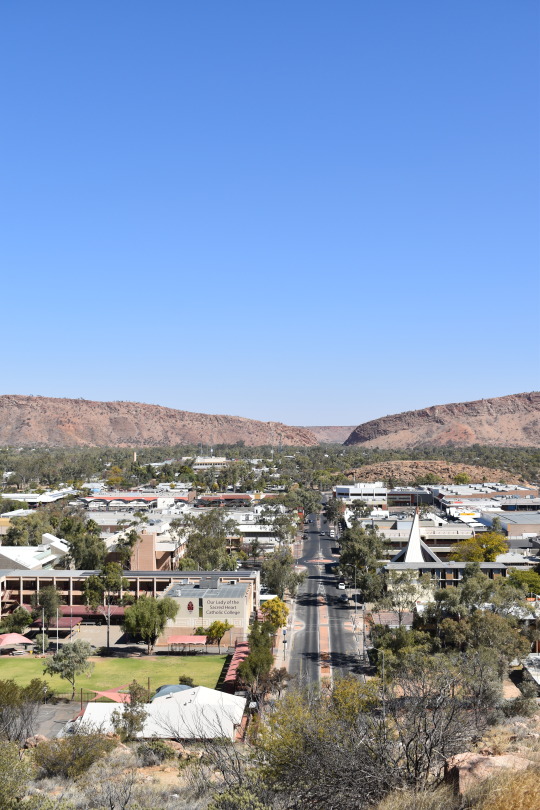
One of my favourite days of the trip was exploring the absolutely breath-takingly beautiful West MacDonnell ranges along the Larapinta trail. We started about 2 hours from Alice at our furthest point, Glen Helen Gorge. It was a deceivingly cold day despite the basking sunshine so we passed on taking the ‘refreshing dip’ here and felt for the many people we saw running who were doing a 4 day Larapinta trail run!

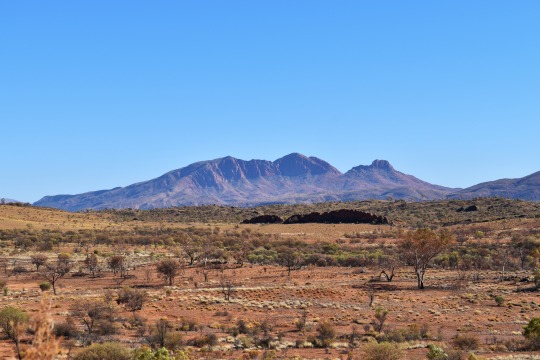

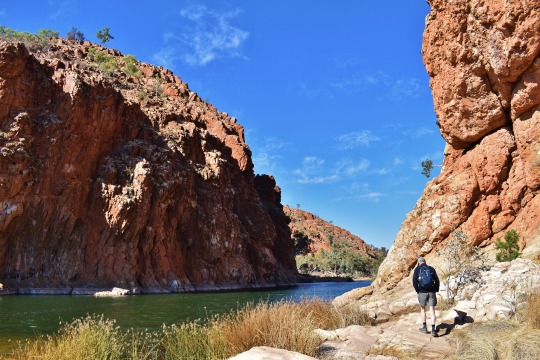
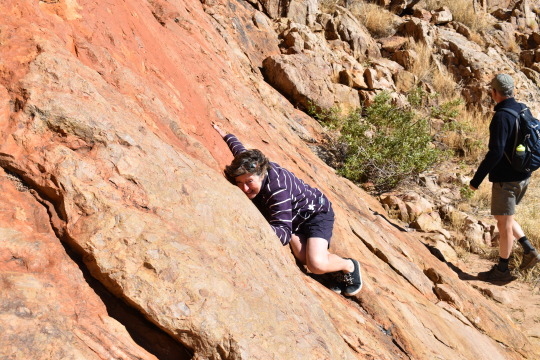
Mum trying to protect herself from the cold wind!
The next stop was the stunning Ormiston Gorge with hike around the top and through the middle of the gorge (which again had no water because dry season!). The other stops along the way are probably best described with photos rather than words. They included the Ochre pits where indigenous people collected ochre to use for rock and body paintings, which they used to tell Dreamtime stories and in ceremony; Serpentine Gorge with a steep hike up to a lookout over the West MacDonnells; Ellery Creek Hole and Simpsons Gap. We had hoped to see a few rock wallabies along the way but unfortunately they may have been hiding away from the cold!
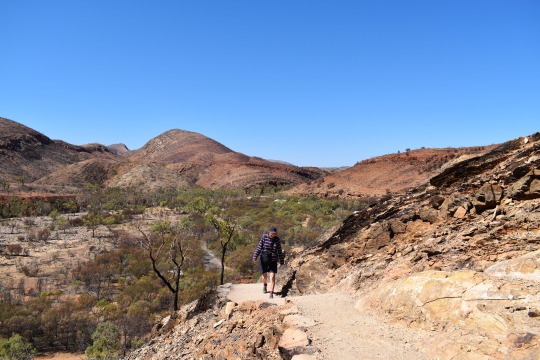

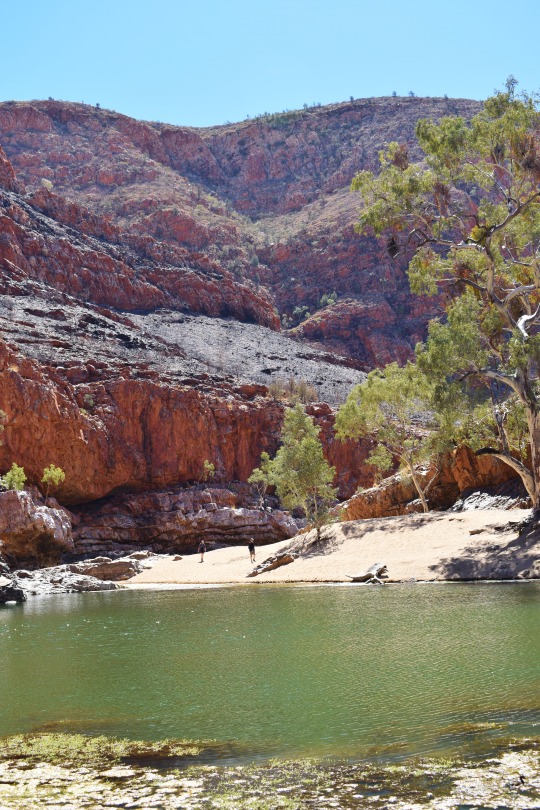
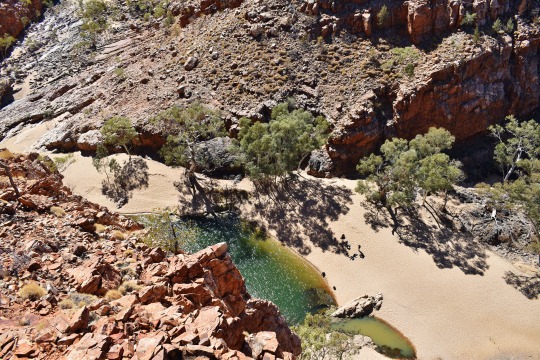
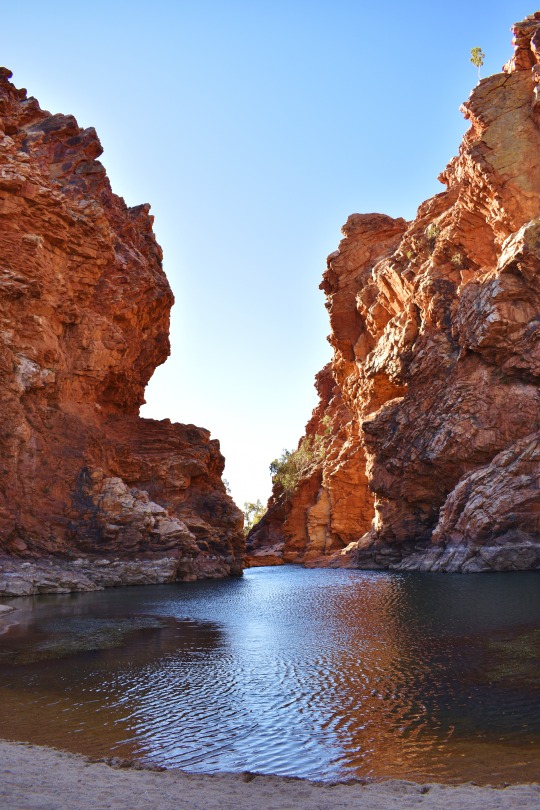
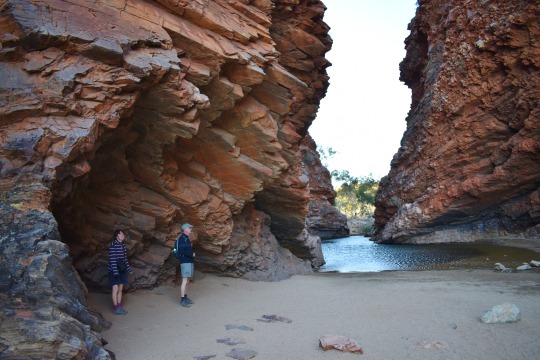
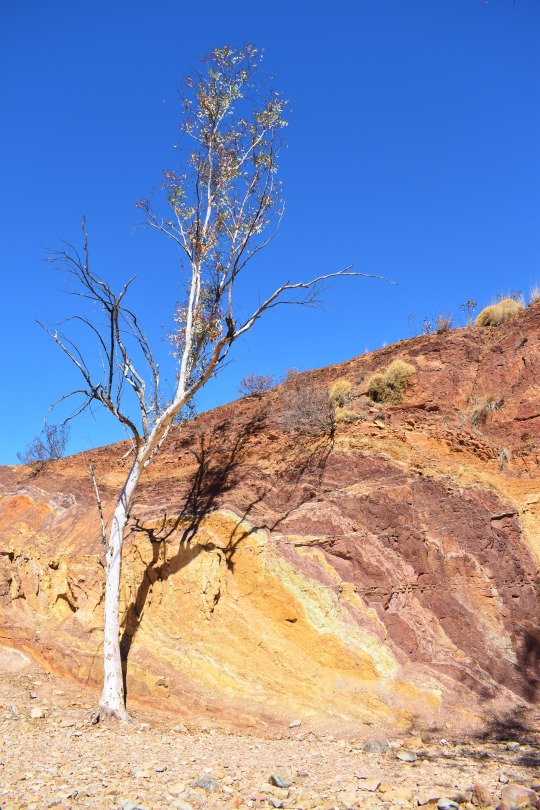
It was a long 5 hour drive down to Yulara (the small resort town for Uluru). 5 hours along a straight road with fairly barren red dirt desert either side; even just this relatively short distance made us appreciate how enormous and sparse this country is. We caught our first glimpse of Uluru and Kata Tjuta from afar as we approached and what a beautiful sight it was! We found a viewing area next to our accommodation where we watched our first of many Uluru sunsets!
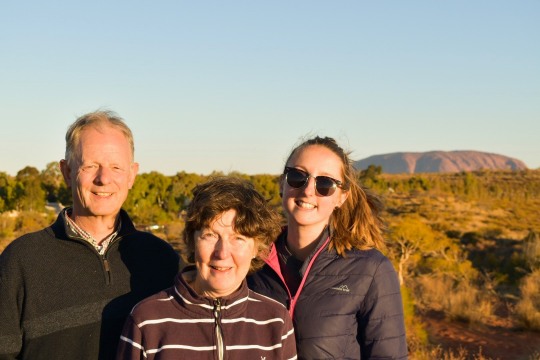
We spent the next 3 days exploring the National Park, learning about the significance of Uluru to the Anangu people and all about the local culture and traditions. Seeing Uluru up close was much more impressive than I'd imagined; what looks like a fairly uniform rock from far away is made of up so many caves and gorges and rock formations which all have cultural significance and stories behind them!


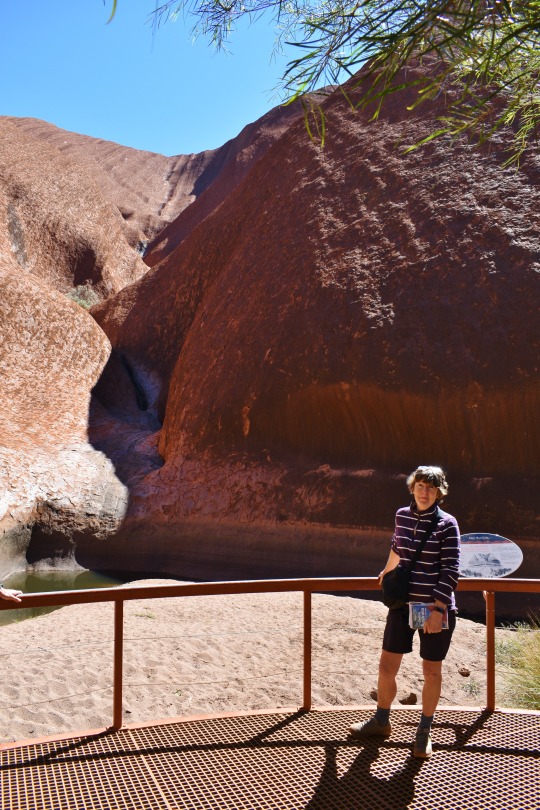
Mutitjulu Waterhole
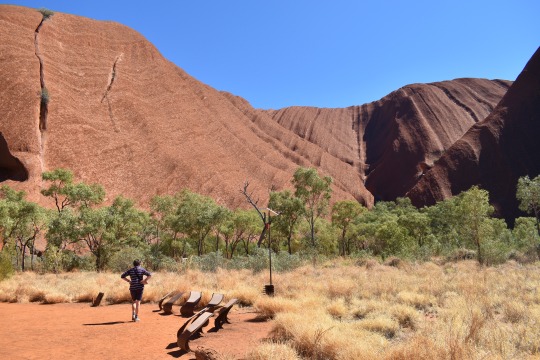
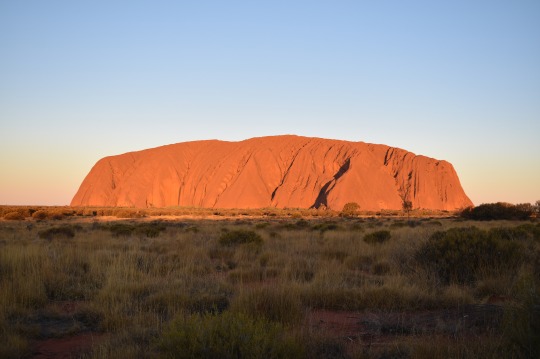
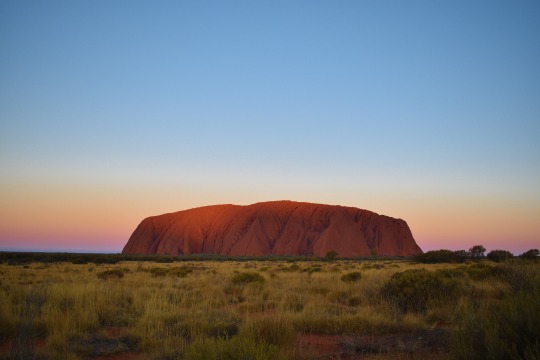
The other place of significance in the National Park is Kata Tjuta (the Olgas) which is a contrasting collection of rocks (the formation of both Uluru and Kata Tjuta seems to be still very much undecided so I’m struggling to know what to call them!). We did an absolutely stunning hike there called the Valley of the Winds with some breathtaking viewpoints.




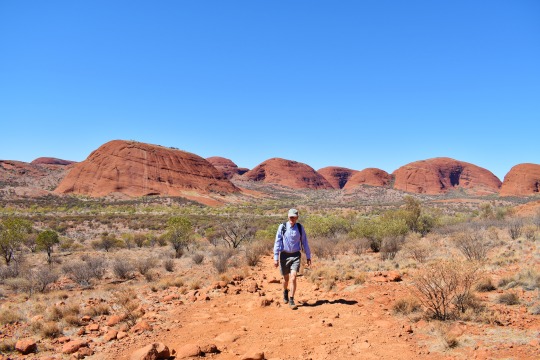
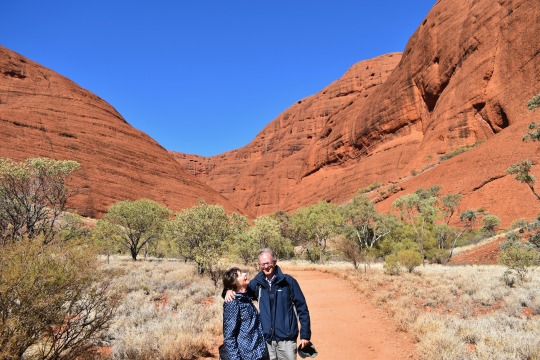
After lots of beautiful sunset viewings, we braved a very early start, armed with a thermos of hot tea, to drive into the Park to watch the sunrise. It was certainly a popular event but we could see why – watching the colours change over Uluru with Kata Tjuta in the distance was just spectacular!
Our legs were exhausted from a lot of hiking so we spent our last day going to workshops and talks put on by the resort, learning about bush tucker, aboriginal hunting tools and even a didgeridoo lesson!
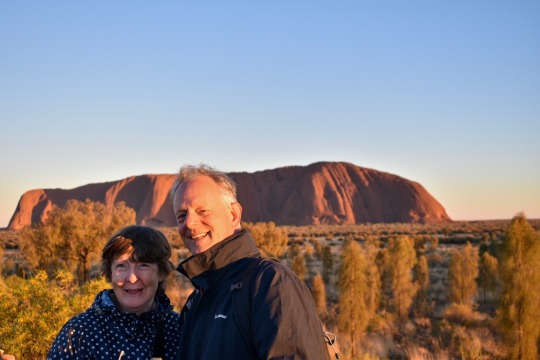
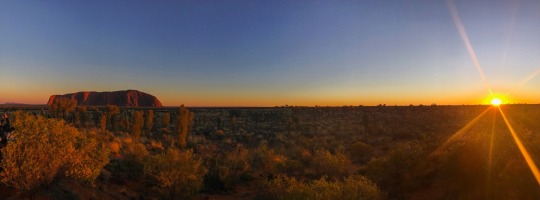
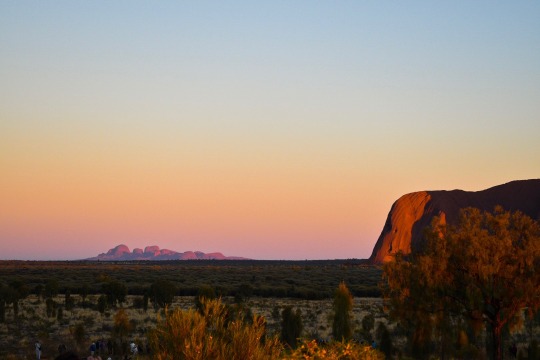
It was time to fly back to Newcastle but what a trip of a lifetime we’d been lucky to experience! It was great to finally show my mum around the place I’ve talked so much about over the past 5 years and to take her back to Sydney to see where they both lived 31 years ago, and meet up with some of their old friends!
Sadly, their life back in England called, so it was another goodbye but we parted ways with so many incredible memories to last a lifetime!
It was back to hospital life and the revision grind for me....
2 notes
·
View notes
Text
100 day update.
I never planned to go to Australia. Of course, at some point I decided that I would come to live here and had to start working towards it. But to be honest, I can’t remember a distinct moment when I thought to myself “Yeah, I definitely want to go to Australia”. I grew up obsessed with Steve Irwin, who fostered my love for animals, and all things that seemed to push the border of normal. Maybe it was something that had been manifesting in me since childhood. Whatever the reason was, I left home knowing next to nothing about the country I was headed to. I knew the names and locations of a few capital cities, and that it was home to some of the world’s most deadly animals, but that was it. Suddenly one day I found myself at the airport saying goodbye to my parents with my backpack, and that was it. I was on a plane, and I had no idea where I was going or what I was getting myself into. I was absolutely terrified, but I couldn’t wait.
Maui was incredible. It was a dream holiday, and exactly what I needed after 70 hour/ 6 day work weeks. Yoga in the mornings, beach hopping, sunbathing, day drinking, jungle trekking, waterfall climbing, snorkeling with sea turtles, and partying the night away with new friends from around the world; it was the perfect “welcome back” to the backpacker hostel lifestyle I had missed. Breathtaking landscapes, friendly hostel mates, delicious food, long days, late nights, and the slow-paced island lifestyle was the cocktail I needed to kick off my working holiday. It was one of those destinations that make you want to freeze time and stay forever. Eventually though I woke me up from my island dream after managing to lose my wallet (the day before moving overseas!? No worries!).I spent most of my last day on Maui on the phone waiting on hold with my bank, eventually my roommate managed to coerce me into an afternoon beach hopping break to relieve me from the stress. I laid on the shore of Makena beach while I reminded myself of Bob Marley (and my Dad’s) words “Every little thing is gonna be alright…”
Sleeping in airport terminals isn’t the most glamorous part of traveling, nor is it my favorite, but it’s something that I’m no longer a stranger to. I had an overnight layover in Honolulu, where the airport welcomes stranded travelers with a designated area to sleep in. While the benches didn’t make the most comfortable bed I’ve ever slept on, I was able to catch a few hours of good rest. In the morning I woke to a beautiful sunrise bidding me a final goodbye from the states, and after the longest walk of my entire life to the other side of the world in the terminal, and a goodbye call to home I boarded my plane. A window seat in econcomy on a budget airline promised me that a year of adventure laid just a sore neck and a close of my eyes ahead.
The day I arrived in Sydney I felt pretty overwhelmed. I had just moved to the other side of the world, and since I’d lost my wallet, I only had the bit of cash I had brought with me. I was feeling pretty grateful for an exchange rate that worked in my favor, a hostel kitchen with 8 (eight!!!!) stoves, and a clean bed to relax in after the journey over. My first priority was to get my money sorted; it didn’t take long for the Sydney sticker shock to set in and I knew I needed to work it out. I was up with the sun my first morning to head to the bank where I learned two things:
1. It gets cold in Sydney (who knew that Australia actually has a winter too?!)
2: It would be over a week before I could get access to my money
Deep breaths, everything is going be alright. Stressing out about it wasn’t going to get me anywhere. I’ve got this; I’ve done the whole hungry budget backpacker thing before. No worries.
In the midst of work/life chaos before leaving home, I had decided to book my first week in Sydney with a tour company. This was my first time doing organized travel and although it lacked a little freedom, I was glad that I had decided on it. They had set up my accommodation for the week and a few meals, so I didn’t have to worry about spending too much until I could get my card. I was grouped with some lovely and hilarious English and Canadians who were also starting out on their working holiday visas. It was comforting to be around people who were in the same boat as me, but it also was a bit strange to be at the mercy of whatever was planned for us. 6 days and 5 nights in Sydney and Port Stephens: complete of course with the obligatory city walking tour and pub crawls. It was an interesting change of pace from the travel that I’m used to. No planning on my part, just “Show up here at this time and we’ll take care of everything for you”. A harbor cruise and boat barbecue, an evening exploring the dazzling VIVID Sydney displays, yoga with kangaroos at an eco-hostel, a hike through Tomaree National Park, boarding through sand dunes, restaurants with food that looks like it came straight out of one of those trendy facebook videos, drinking games, nights out dancing, and a sales pitch just every now and then to gently remind you that your tour leader was getting paid to hang out with you. While it was fun to have my days filled with things that I probably wouldn’t have done on my own, I was desperate for a little independence which I was able to find at a couchsurfing meet-up.
I fell in love with couchsurfing while I was in Ireland a year ago. I was in Dublin, my first big city on my solo Europe trip and I joined a meet up for a hike on the coast of Howth, a fishing village an hour bus ride outside of the city. After our walk through the cold wind and rain, we took refuge at a jazz and blues festival pub crawl. Hours went by chatting to each other and listening to music before heading back into the city together. I had never met so many people from so many different places, and being new to traveling it blew my mind to feel so welcomed by everyone; I knew that I would definitely be doing it again. Shortly after I had gotten home from Europe I started attending meet up every week in Phoenix. I haven’t surfed yet, but I definitely plan to soon. When I got to the bar in Sydney, I was greeted by friendly faces, and after watching fireworks over Darling Harbor, I was invited to head to someone’s flat for pre-drinks followed by a Friday night out. I didn’t need much convincing, but the promise of free drinks and new friends made any hesitations I might have had disappear.
After a week in Sydney, I was ready to move on. My bank was going to forward my card to me, so all that was left to do was set up my phone plan, book my flight, and then I was ready to head out on the next chapter of my journey. After a bus ride, a flight, another flight, a bus, a few hours of sleep, and another bus, I arrived at my new home away from home. The Northern Territory: home of crocodiles, and barra fishing; where winter is a sunny 40 degrees Celsius, and men brag about the size of their fish. I would be spending the next 88 days working remotely in Kakadu National Park. Remote work is required by Australian Immigration to extend your Working Holiday visa from 1 year to 2 years. Where and what you can do depends on which visa you are on. But for me, this meant administration work at a hotel.
My bus left from Darwin at 6:30 in the morning, and after a 3.5 hour ride through the middle of nowhere, the bus pulled over and it was my turn to get out. It felt like a scene from a movie, getting off the bus with my backpack, walking through the doors of this little green hotel in the desert. Things moved pretty quickly as soon as I arrived and I started work the next day. It took a few days to get situated, but everyone I worked with were backpackers, so it didn’t feel too unfamiliar. What did take some getting used to was the isolation.
Kakadu National Park is more than half the size of Switzerland, and with a population totaling just 1130 people, it’s easy to feel small in such a big space. The hotel is a half hour drive from Jabiru, the only town in the park, which boasts a shopping center featuring a small grocery market, library, bank, police station, hairdresser, and an Olympic sized swimming pool (to which I regularly wonder how on earth they managed that). It’s pretty much impossible to get anywhere around the park if you don’t have a car without hitchhiking, however I managed to make it away from the hotel quite a few times in my first month. My first trip was to Yellow Water Billabong. We spent the afternoon on a river cruise learning about some the Aborignal history in the park and the unique wildlife, bird watching, looking for buffaloes, and of course, spotting crocs. A few days later we were off to Ubirr, the largest rock art site in Australia. On our way, we stopped at Cahills Crossing, the border to Arnhem land, where the aboriginal community live. At high tide when the river flows over the crossing, you can be eaten alive by mosquitoes while watch crocodiles at the edge of the water, waiting for fish to be pushed into their mouths. After finishing the climb to the top of Ubirr, you are welcomed by a 360 degree view of the park. Being there felt like I had been taken back to the Jurassic age. Looking out across the wetlands, I half expected to see a dinosaur, or lions and elephants walk across the plains. During this time of year, Wurrgeng season, the locals burn the land to prevent bush fires and help restore nutrients to the soil. The smoke from the controlled burns turns the sky beautiful colors, and the sun a deep glowing red. It’s a picture that each time I’ve visited reminds me of the opening scene from The Lion King.
Remote living is a unique experience. You work, sleep, eat, live, and play all in the same place with the same people. Imagine laying out in your backyard at the pool with a book on your afternoon off, then your manager walks through your back gate to let you know that the schedule has changed and now you need to be back in the office to close in half an hour. It’s your day off and you’re having a late breakfast in your kitchen in your pajamas, and in they come to tell you all of the things they would like you to do tomorrow. Work-life balance does not exist, they are one and the same. This made the work become frustrating quickly, and management challenging to deal with to say the least. As staff you quickly learn to rely on each other: celebrating small victories together, acting as an outlet for frustration, and taking a little extra time and effort to do things as a group. I found the answers to “what will I do tonight?” were different than they had ever been. Taking dinner out to the grass for a picnic instead of eating in the kitchen, grabbing a beer and going for a walk to the billabong at the back of the hotel, being workout buddies at the gym, drinking until late (which now meant 10pm) doing puzzles, playing and billiards in the rec room, or playing cards sprawled across the floor of your hotel room.
Of course my favorite days were my days off. While there were certainly hardships to living in the middle of nowhere without my own mode of transportation, it was the first chance I’d had in a long time to learn how to live life slowly. I no longer had to wake up early on my day off to make it to Bikram Yoga, or run to the grocery store and spend hours cooking in the kitchen (although I do miss those things dearly now). I could be lazy ,and not feel bad about it! I could sleep until my body decided it was time to get up, head to the gym when I felt like it, float in the pool for hours, listen to a podcast during a walk through the forest, read a book in my hammock, practice yoga at the gym, and still have hours left in the day to burn (my hula hoop, of course). And on the days when I felt like I had cabin fever coming on, I had the entirety of the park at my doorstep. A spur of the moment decision and catching the boss in a good mood meant you could ask for the keys to the company car. Maybe having an early afternoon off meant going for a drive to the Mamukala Billabong for some birdwatching, over to Burrunkguy to admire more rock art, and then to Nawurlandja to watch the sunset. On one of my lucky days I had the day off with someone with a car and we took the 3 hour drive through the park to Gunlom Falls. A 25 minute hike up a steep cliff led us to breathtaking views at the top of the waterfall (and with crocodiles being one of the most populous residents of Kakadu) meant one of the rare chances to swim in the infinity pools. One day after catching a late bus and being temporarily stranded, I even worked up the courage to try hitchhiking. It was a rough go at first, but after half a bottle of sunscreen I got picked up by a fisherman that took me to the South Alligator river. We cast a line out together and watched crocodiles swim by before taking me back to the hotel.
As backpackers, this was only our temporary home, and we all had another adventure planned when our 88 days came to an end. The nights before we said good bye were always my favorite: both fun and bittersweet. The bonds that formed over such close quarters always hurt a bit to sever, but it was impossible not to be excited for them to continue on their own journey.
One of the biggest things I have learned from traveling is to let go of my expectations. I didn’t really know what it would be like or what would happen living here, but I can say easily that most of this had never crossed my mind. The past 100 days have been a roller coaster ride of emotions and adventure, and as I enter my last week at Aurora Kakadu, I can’t contain my excitement for the future. I’m so grateful to all the people I have met along the way. What an incredible opportunity, to live in such a uniquely beautiful place (I mean come on, how many people can say that they’ve lived in a National Park that’s a dual listed UNESCO World Heritage site?!). It’s offered a unique glimpse into Aboriginal culture, and it has been a once in a lifetime experience that I will never forget. I’m looking forward to getting back on that bus in a few days and taking all the lessons that I’ve learned with me on my way. In 8 days I will be on a plane on my way to Queensland (home to the zoo of my childhood hero) to explore The Daintree Rainforest, and The Great Barrier Reef.
100 days down since leaving home, 269 days left in Australia, and then…. We’ll see.
11 notes
·
View notes
Text
15 Excellent Indigenous Art Centres To Support And Celebrate!
15 Excellent Indigenous Art Centres To Support And Celebrate!
Indigenous Art
by Sally Tabart
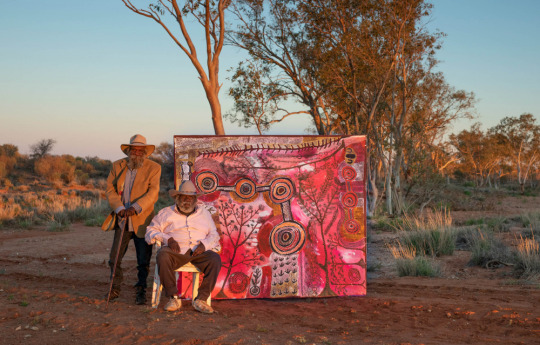
Peter Mungkuri and Alec Baker with their collaborative painting ‘Nganampa Ngura (Our Country)’ (2020) Photo – Meg Hansen, Courtesy of Iwantja Arts.
It’s important to know that Aboriginal artists and art centres are not all one homogenous group – each have their own style, stories, methods, materials and traditions that are unique to their Country and culture, that often cannot be practiced elsewhere. Through the artwork produced in community art centres there is so much to be learned about the spirit, culture and history of our country’s First Nations people.
There are a few things to keep in mind when purchasing artwork by Indigenous artists. Supporting art centres that are Aboriginal owned, operated and governed means that economic autonomy remains within the community. I asked Shilo McNamee, Darwin Aboriginal Art Fair Foundation’s (DAAF Foundation) artistic director, why this is important.
‘Art Centres are the beating heart of Indigenous communities. Supporting art centres ensures that Australia’s Indigenous art sector continues to flourish and excel’, she says. ‘The economic independence of communities helps ensure that people can continue to live on their homelands, resulting in the preservation of traditional practices, ceremonies, language, art and spirituality.’
Another important thing to look out for is that the art centre (or anywhere you are purchasing Aboriginal artwork from!) is a signatory of the Indigenous Art Code (IartC). This is a code of conduct (the Code) that art dealers, art centres and galleries can join to demonstrate their commitment to fair and ethical dealings when working with Indigenous artists. When art centres become signatories of the IartC, they are considered Dealer Members. ‘These businesses are committed to the fair and ethical trade with Aboriginal and Torres Strait Islander artists, and transparency in the promotion or sale of artwork’, says Gabrielle Sullivan, CEO of the Indigenous Art Code. ‘Dealer Memberships signifies a commitment to act fairly, honestly, professionally and in good conscience in all direct or indirect dealings with artists.’ Members of the IartC will generally display a logo on their website. You can read more about the IartC’s recommendations for buying ethically here.
As far as what percentage of an artwork purchase goes directly back to the artists, DAAF’s Executive Director Claire Summers notes an industry standard as guideline. ‘Art centres have systems in place to ensure artists are paid ethically. It is an industry standard for artists to receive 60 per cent of the sale price, with 40 per cent returning to the Art Centres, to continue their important work in the community’, she says.
You should also expect to receive a Certificate of Authenticity (CoA) with artwork purchases over $250.
Now you’re equipped with the information to make an ethical purchase from an art centre – WHERE TO START? Many art centres have great websites and Instagram pages where you can learn more about the artists, their Country and their practice, and shop their artwork online. The Darwin Aboriginal Art Fair – who return 100% of all sales directly to the participating artists and art centres – has recently announced they will be going online this year from August 6th – 11th (check out their list of all 75 participating art centres and register for early access here), and the annual Tarnanthi Festival in South Australia has a great online portal for navigating their Art Fair’s participating art centres here.
To get you going, we’ve put together a list of 15 art centres that are Aboriginal owned and operated, signatories of the Indigenous Art Code, and showcase a diverse range of the incredible work being produced by artists of the world’s oldest living culture.
Please note this is by no means an exhaustive list – according to the IartC, there are over 60 Aboriginal and/or Torres Strait Islander-owned art centres who are members of the IartC! This is a place to start – we encourage you to keep looking, learning, supporting and celebrating!

Left: Betty Muffler with her painting ‘Ngangkari Ngura’ (2020). Right: Eric Barney with his painting ‘Ngura (Country)’ (2020). Photo – Meg Hansen, Courtesy of Iwantja Arts.

Tiger Yaltangki with his painting ‘Self Portrait’ (2020). Photo – Meg Hansen, Courtesy of Iwantja Arts.
Iwantja Arts
Iwantja Arts is located in the rocky, desert country of Indulkana Community on the Anangu Pitjantjatjara Yankunytjatjara (APY) Lands in the remote north-west of South Australia. Founded in the 1980s by respected Anangu artists and community leaders Alec Baker and Sadie Singer, Iwantja Arts now supports the artistic careers of over 40 predominantly Yankunytjatjara artist members, providing access to artistic and professional development.
Many renowned artists have been nurtured and supported at Iwantja Arts, including Sulman Prize-winning Kaylene Whiskey and Vincent Namatjira, who became the first Aboriginal artist to win the Archibald Prize in 2020.
Artist Vicki Cullinan says, ‘The Iwantja art centre is the most important place in our community. It’s a place where everyone comes together, young and old. It’s really special. Families are working together. A lot of times people are singing inma (cultural songs) while they work. Iwantja Arts is a place where people can work to make money for their families. Everyone needs a job and working as artists means that we are also keeping our culture strong and passing on important knowledge to the next generations.’
Visit the Iwantja Arts online store here and follow them on Instagram here.

Left: ‘Iwantja Tjukitji (Iwantja Soakage)’ by Julie Yatjitja of Iwantja Arts. Right: Leah Brady, at the APY Studio in Adelaide.

Left: Nyunmiti Burton in front of her painting at APY Gallery Adelaide. Right: ‘Kapi Tjukula’ by Yaritji Heffernan.
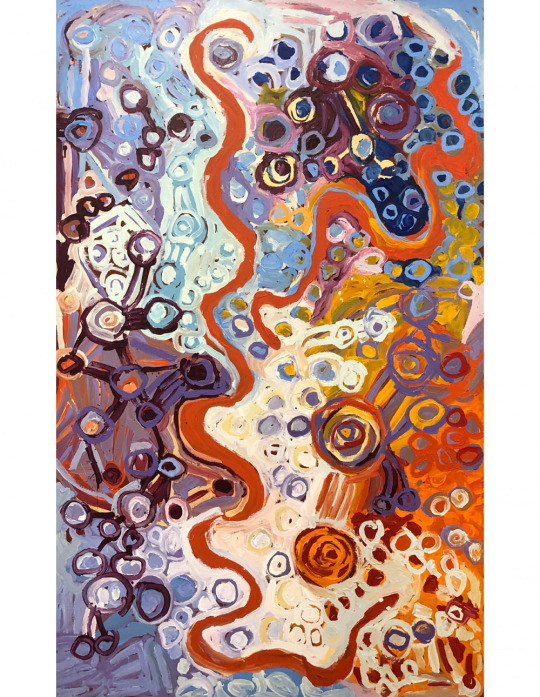
‘Wanampi Tjukurpa’ by Kukika Adamson.
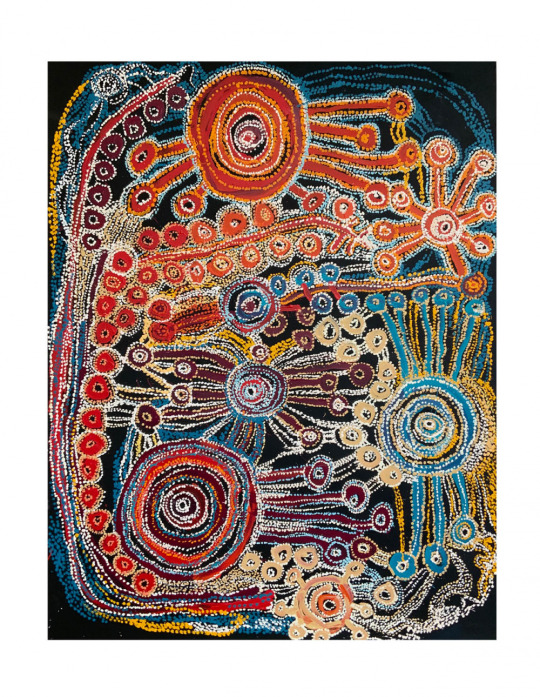
Artwork by Sharon Adamson of Tjala Arts.
APY Gallery
The Anangu Pitjantjatjara Yankunytjatjar (APY) Centre Collective is a group of 11 Indigenous owned and governed enterprises. The APY Galleries in Adelaide and Sydney are run by APY Art Centre Collective, creating a platform to exhibit and celebrate the work of young and emerging APY Artists.
The Anangu Pitjantjatjara Yankunytjatjara Lands (APY Lands) are located in remote Central Australia. The galleries represents the work of seven art centres – Mimili Maku Arts, Tjungu Palya, Ninuku Arts, Tjala Arts, Iwantja Arts, Kaltjiti Arts, and the Tjanpi Desert Weavers – facilitating sales and marketing the work of over 500 Indigenous artists. APY Art Centres are powerful places, and vital to the community.
The APY Galleries showcases artists working across a wide range of mediums from painting, traditional punu (wood) carving, weaving, textiles, new media and digital photography. These emerging young artists have watched, listened and learned from their grandparents, the senior men and women of the APY Lands.
Visit the APY Gallery online store here and follow them on Instagram here.

Epic woven hat by Doreen Djorlom of Marrawuddi Art Centre. Photo – courtesy of Marrawuddi Art Centre.

Weaving by Melba Gunjarrwanga of Marrawuddi Art Centre. Photo – Marrawuddi Art Centre.

Amy Namarnyilk and her partner Rodney, with Amy’s incredible weavings! All hand woven with pandanus, which have been collected and dyed with natural dyes. Photo – courtesy of Marrawuddi Art Centre.

Patsy Kelly and her sensational Marebu! Photo – courtesy of Marrawuddi Art Centre.

Painting by Robert Namarnyilk of Marrawuddi Art Centre.
Marrawuddi Arts Centre
Marrawuddi Arts & Culture is located in the heart of the Kakadu National Park and works with over 400 artists from the Kakadu and West Arnhem region. Marrawuddi is a vibrant community hub providing working space for artists, stunning artworks for tourists to view and purchase and excellent coffee for everyone. Recently relocated to a stunningly renovated space right in the town of Jabiru, Marrawuddi is the first business to secure a lease under the post-mining plans for of Jabiru. The town was handed back to the Mirarr traditional owners in June 2021 as part of the long-awaited transition away from imposed uranium mining.
Artists at Marrawuddi practice painting methods that draw on traditions used for thousands of years. Using manyilk (sedge grass) and ochre, artists create patterns called rarrk, commonly known as cross hatching. Contemporary art methods such as screen printing and fine art painting are also practiced here, and the daluk (women) of Kakadu and West Arnhem also create incredible pandanus fibre art. Alycia Marrday of Marrawuddi Arts & Culture is a finalist in the Handcrafted category of the 2021 TDF Design Awards!
Marrawuddi is owned and controlled by the Mirarr clan through their representative organisation the Gundjeihmi Aboriginal Corporation (GAC).
Mirrar Traditional Owner Simon Mudjandi said at the opening of Marrawuddi’s bright new location in 2020, ‘Today is the start of a new and exciting chapter for Jabiru and Kakadu. With the opening of the new Marrawuddi Arts Centre, Jabiru’s transition from mining town to an Aboriginal owned community centre and tourism hub really begins.’
Visit the Marrawuddi online store here and follow them on Instagram here.

Artwork by Gwenneth Blitner of Ngukurr Arts. Image – courtesy of Ngurkurr Arts.
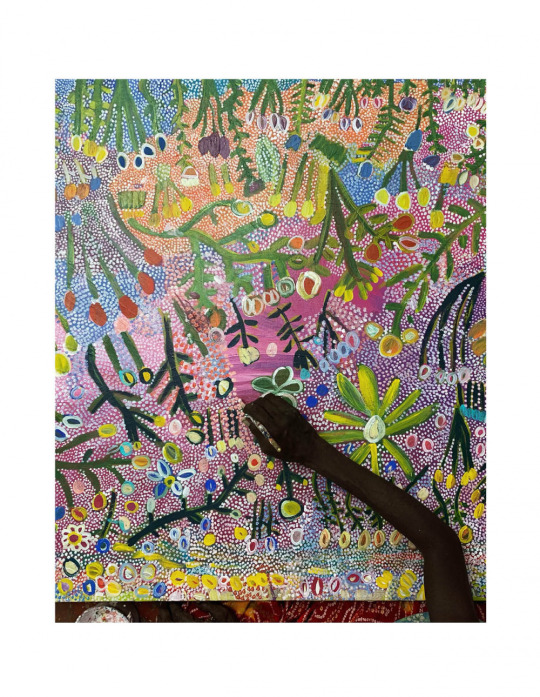
Gwenneth Blitner at work! Photo – courtesy of Ngukurr Arts.

‘Crayfish’ by Wally Wilfred Ḏakawa of Ngukurr Arts. Image – courtesy of Ngurkurr Arts.
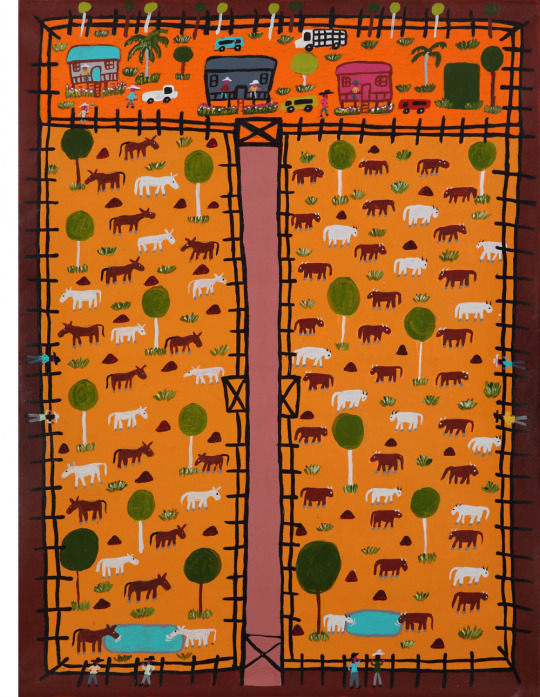
‘Station Life’ by Jill Daniels of Ngukurr Arts. Image – courtesy of Ngurkurr Arts.
Ngukurr Arts
Ngukurr Art Centre is positioned by the banks of Roper River, at the south-eastern most cusp of Arnhem Land. The Art Centre, much like Ngukurr (which means ‘place of many stories’), is abundant with diverse histories, traditions and stories – bringing together many different clans and language groups. The community is home to Ngalakgan, Alawa, Mangarrayi, Ngandi, Marra, Warndarrang, Nunggubuyu, Ritharrngu-Wägilak and Rembarrnga, known collectively as Yugul Mangi (meaning ‘all of us together’). Here, the artists draw from personal history, cultural memory, Ancestral knowledge, ceremonial responsibilities and varied artistic influences, experimenting with colour, form and representation.
‘Melabat plenti langgus mob bat melabat bin migim wan pipurl. Dismob ting migim melabat strongbala,’ says senior culture man 78-year-old Walter Kolbong Rogers. Translating from Roper Kriol he says: ‘We are many language groups, but we came together and now we are one people. This art makes us strong.’
Visit the Ngukurr Arts online store here and follow them on Instagram here.
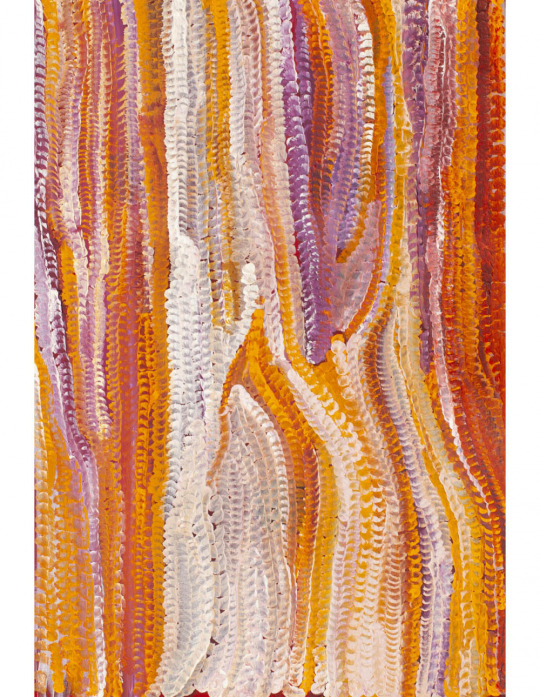
‘Wantili’ by Cyril Whyoulter of Martumili Artists. Image – courtesy of Martumili Artists.

‘Parnngurr Community’ by Bugai Whyoulter of Martumili Artists. Image – courtesy of Martumili Artists.

Martumili artists Elizabeth Toby and Lorna Linmurra. Photo – Kate Shanasy.

Left: Martumili artists painting at the art centre. Right: Artist Judith Anya Samson. Photo – Kate Shanasy.

From Left to right: ‘Untitled’ by Ivy Bidu, Untitled by Bugai Whyoulter, Nyurnma by Muuki Taylor of Martumili Artists. Images – courtesy of Martumili Artists.
Martumili Artists
Martumili Artists was established by Martu people living in the communities of Parnpajinya (Newman), Jigalong, Parnngurr, Punmu, Kunawarritji, Irrungadji and Warralong. The artists and their families are the traditional custodians of vast stretches of the Great Sandy, Little Sandy and Gibson Deserts as well as the Karlamilyi (Rudall River) area.
Bright, bold and expressive art making represents the exuberant personalities of the Martu people.
Younger Martu artists typically begin painting with their parents, grandparents and extended family, fostering an organic process of learning – not only about painting techniques, but also specific locations, family histories, traditional ways of life, bush tucker and Jukurrpa (Dreaming).
In this year’s Vivid festival in Sydney (postponed to September this year), eight Martumili artists will have their work light up the sails of the Sydney Opera House, bringing to life their 2013 collaborative artwork ‘Yarrkalpa (Hunting Ground), Parnngurr Area’!
Artist Corban Clause Williams of Martumili talks of the transfer of cultural knowledge from senior Martu artists to the younger generation: ‘The old people, they sit down and paint and tell stories of the old days, and we listen and learn.’
Visit the Martumili online store here and follow them on Instagram here.

Pirrnpirrnga – Desert Bore by Ann Lane Nee Dixon of Ikuntji Artists. Photo – courtesy of Ikuntji Artists.
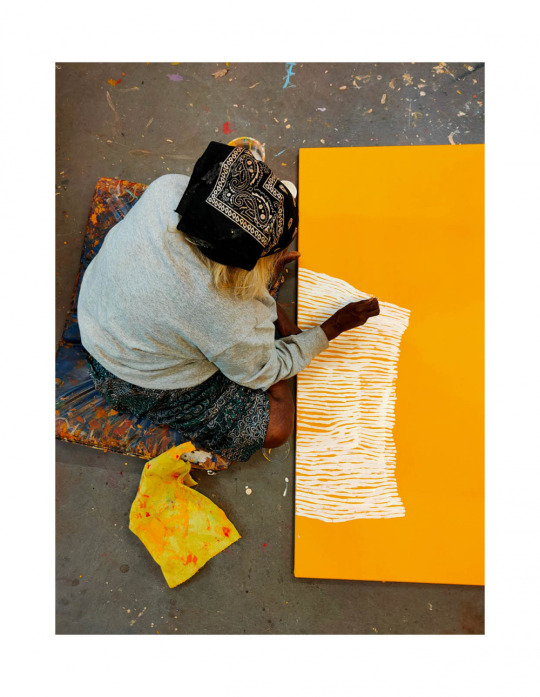
Artist Eunice Napanangka Jack working on a painting for a show. Photo – courtesy of Inkuntji Artists.

An Ikuntji artist working. Photo – courtesy of Inkuntji Artists.

Sheraldeen Marshall modelling pieces from the beautiful Inkuntji Artists x Publisher Textile collection! Photo – Christian Koch
Ikuntji Artists
Founded in 1992, Ikuntji Artists was the first art centre established by women in the Western Desert Art Movement.
Situated in the community of Haasts Bluff (Ikuntji) in Central Australia, which has a population of around 150 people, Inkuntji Artists has a board of seven Indigenous directors all of whom live and work locally.
Known also for their textile designs, recently Inkuntji have collaborated with Publisher Textiles on a clothing collection featuring the bold textile designs by artists Keturah Zimran, Mavis Nampitjinpa Marks, Eunice Napanangka Jack, Lisa Multa and Leonie Kamutu the collection shortlisted in the Textile Design category for the TDF Design Awards!
Artist and textile designer Keturah Zimran says, ‘I feel really proud of myself and my kids, seeing the paintings on the clothes. My dream is to keep doing the paintings, to keep going..… so I can teach my grandkids.’
Visit the Inkuntji Artists online store here and follow them on Instagram here.
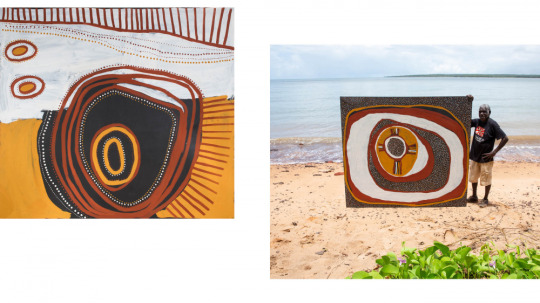
Left: Ngiya Murrakupupuni by Dino Wilson of Jilamara Arts. Right: Timothy Cook with his painting Kulama and his Country Mananowmi in the distance, 2021. Photo – Will Heatcote for Jilamara Arts
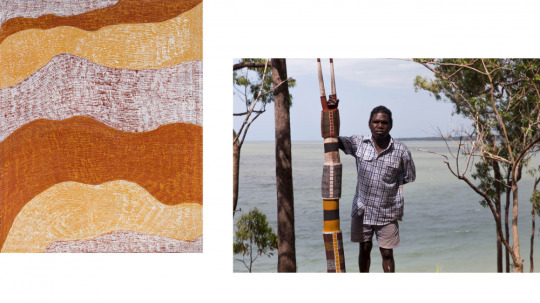
Left: Ngiya Murrakupupuni by Michelle Woody Minnapinni of Jilamara Arts. Right: Pedro Wonaeamirri with his Tutini for NIRIN BoS, 2020. Photo – Will Heathcote for Jilamara Arts
Jilamara Arts + Crafts Association
Located in the community of Milikapiti on the north coast of Melville Island (off the coast of the Northern Territory), Jilamara Arts + Crafts Assoication represents Tiwi art from up to 60 local artists. Established in 1989, they are highly respected for work based on jilamara (body paint design), Tiwi creation stories and unique island ceremonies such as Kulama and Pukumani.
The Tiwi Islands have been separated from mainland Australia for at least 3000 years, leading to the development of regionally distinct creative practices.
Jilamara Arts and Crafts is fully owned and governed by Tiwi artists from the Milikapiti community, led by an Executive Committee of nine elected Tiwi directors.
‘We live on a remote community. It is time for us to be seen and heard. We want people to recognise how strong our culture is. Glimpse how beautiful and complex our culture is, our families, our counties, our history, our future. We adapt, we evolve, we change, we create as we write into the future’, says artist Colin Heenan-Puruntatameri.
Visit the Jilamara online store here and follow them on Instagram here.

Left: Weaving by Evonne Munuyngu of Bula’bula Arts. Right: Banda (Long Neck) by Roy Burnyila of Bula’bula Arts
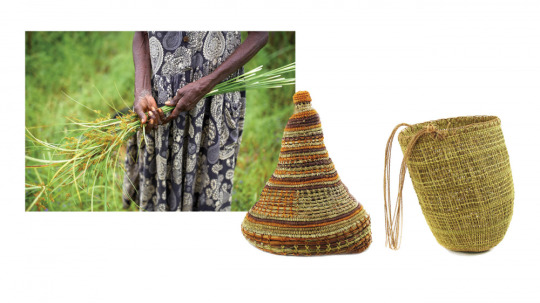
Left to right: Collecting for weaving, Weavings by Janice Djupuduwuy and Julie Djulibing Malibirr of Bula’bula Arts.
Bula’bula Arts
Based in the Yolgnu community of Ramingining in central Arnhem land, Bula’bula is an arts centre supporting 150 artists from the town and surrounding art stations. The centre’s online store sells bark and canvas paintings depicting stories of Yolgnu culture in ochre, white clay and charcoal; as well as weavings and fibre art woven from locally harvested materials such as pandanus, sand palm and kurrajong bark stained with natural dyes made from fruits, roots and leaves.
Visit the Bula’Bula Arts online store here and follow them on Instagram here.

Artwork by Johnny Warrkatja Gapuwiyak Culture and Arts. Image – courtesy of Gapuwiyak Culture and Arts.
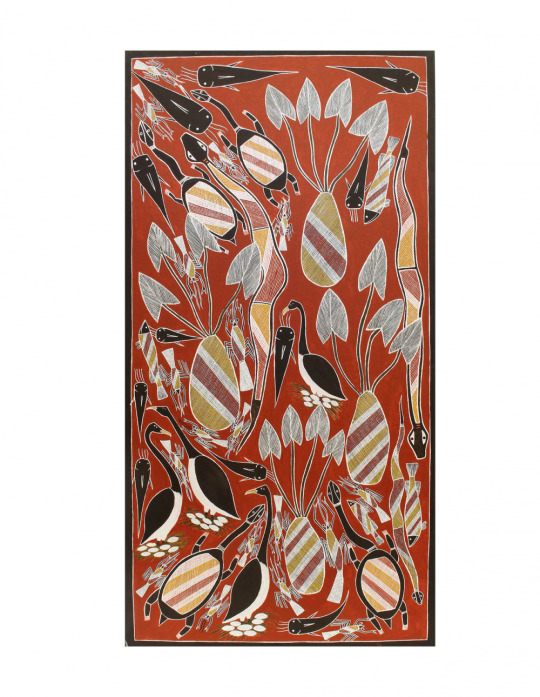
Artwork by Johnny Warrkatja of Gapuwiyak Culture and Arts. Image – courtesy of Gapuwiyak Culture and Arts.
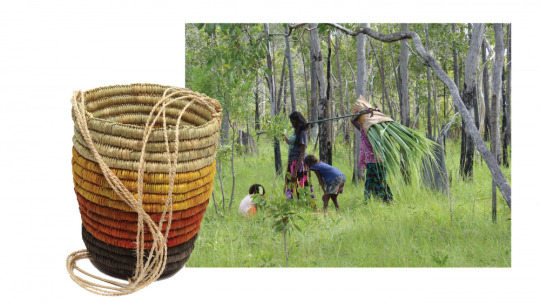
Gapuwiyak Culture And Arts
Gapuwiyak Culture and Arts is a remote Art Centre in east Arnhemland. There are eighteen clans in this region, each with their own interconnected clan estates, songs, patterns and designs.
The Art Centre is owned by Yolŋu members, have a Yolŋu Board, and employ a manager and arts workers, and supports over 100 artists from Gapuwiyak and surrounding homelands.
Artist Jason Marrkula is a Traditional Owner for the Gapuwiyak tribe and says ‘I like to share my culture with people through my art or by taking them to my land. I share my dreams, my stories with my mind and with my heart so people can learn about the land, the birds, the nature and our culture. This is really important for me.’
Visit the Gapuwiyak online store here and follow them on Instagram here.
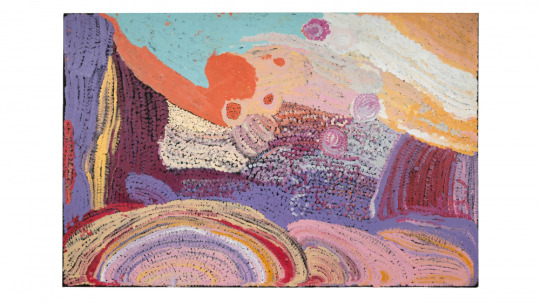
‘Untitled’ by Mulyatingki Marney and Nancy Nyanjilpayi of Spinifex Hill Artists.

‘Untitled’ by Nyangulya Katie Nalgood of Spinifex Hill Studio.

‘Wantili’ by Country Ngamaru Ngamaru Bidu of Spinifex Hill Studio.
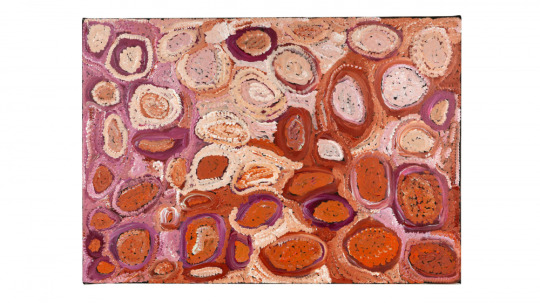
‘Jarntinti’ by Nyanglpayi Nancy Chapman of Spinifex Hill Studio.

Left: ‘Untitled’ by Doreen Chapman of Spinifex Hill Studio. Right: ‘Untitled’ by Selena Brown of Spinifex Hill Studio.
Spinifex Hill
Spinifex Hill Studio stands on Kariyarra Country in the Pilbara region of Western Australia. It is home to one of the youngest Aboriginal art collectives in the north-west of Australia, Spinifex Hill Artists.
Over 100 emerging, mid-career and established artists make regular use of the Studio facilities, with a primary focus on contemporary acrylic painting in bright, confident colours. These are artists from many different language groups, including Kariyarra, Banyjima, Mangala, Manyjiljarra, Martu, Noongar, Nyangumarta, Nyamal, Nyiyarparli, Walmajarri, Warnman, Yamatji, Yindjibarndi.
Spinifex Hill differs from others in this list in that it is managed by FORM, a Western Australian non-profit cultural organisation. The Studio, the Spinifex Hill Artists, and FORM’s Pilbara-programming is supported through a long-term partnership between FORM and BHP.
After 8 months in construction, Spinifex Hill has just celebrated the opening of a brand new, beautiful Project Space with a new group exhibition, Where We Go to Paint (you can view the catalogue here).
Spinifex Hill Artist Maggie Green (stay tuned for our TDF Collect exhibition with Maggie later this year!) says, ‘We do painting good here. Everyone coming here for painting.’
Visit the Spinifex Hill online store here and follow them on Instagram here.
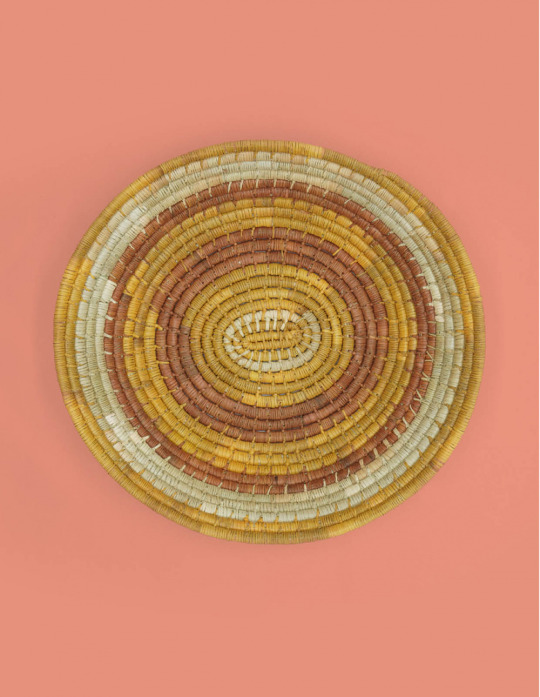
A woven piece by Numbulwar Numburindi artists. Photo – courtesy of Numbulwar Numburindi.

A woven piece by Numbulwar Numburindi artists. Photo – courtesy of Numbulwar Numburindi.
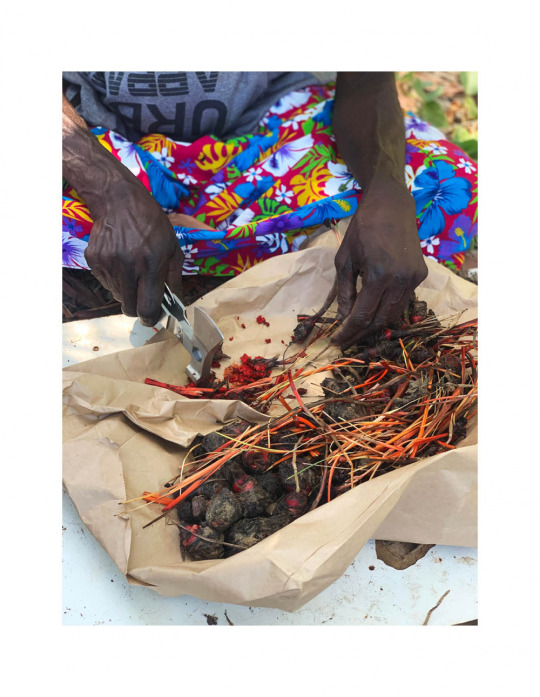
Photo – courtesy of Numbulwar Numburindi artists.
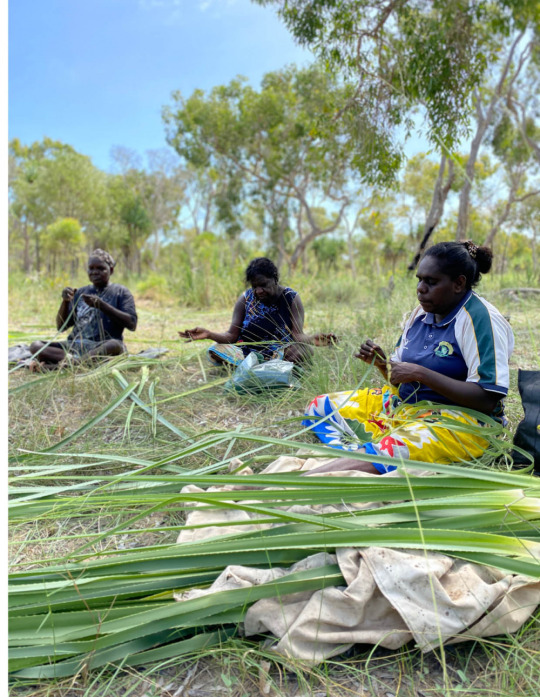
Ladies with pandanus. Photo – courtesy of Numbulwar Numburindi artists.

Woven pieces by Numbulwar Numburindi artists. Photo – courtesy of Numbulwar Numburindi.
Numbulwar Numburindi Arts
Numbulwar Numburindi Arts (NNA) was established in 2019, and is Numbulwar’s first art centre. It is Located on the Rose River on the western coast of the Gulf of Carpentaria (Northern Territory).
Here, artists combine naturally-dyed and locally-harvested pandanus with bright and bold ghost nets, abandoned fishing nets retrieved from Numbulwar’s shorelines. By harvesting ghost nets, the artists perform a modern act of caring for Country, and use the found materials to create intricate wulbung (baskets) and yir (dilly bags).
NNA IS 100% owned and and controlled by the Numburindi people, and employs Numburindi arts workers in the daily running of the Centre
Artist Lillian Joshua explains a little more of the collection of the nets used in NNA works: ‘My son is a sea ranger. He picks the ghost nets up and brings them to the old ladies to use with their weaving, saving marine life, as they are dangerous for animals like turtles and seals.’
Visit the Numbulwar Numburindi Arts online store here and follow them on Instagram here.
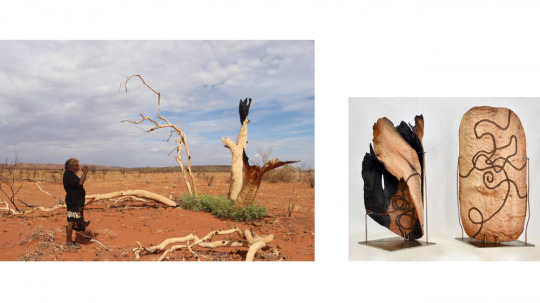
Left: Cynthia Burke on Country, Right: Artwork by Cynthia Burke of Maruku Arts.

Artwork by Niningka Lewis of Maruku Arts.
Maruku Arts
For 35 years Maruku has operated as a not-for-profit art and craft corporation across 22 communities in the NPY Lands, serving more than 500 artists. They are 100% owned by Anangu (Aboriginal people of the Pitjantjatjara, Yankunytjatjara and Ngaanyatjara language groups). Maruku Arts is the only organisation concentrating on punu (wood carving) in the Central and Western Desert area.
Maruku, literally means “belonging to black”, today is one of the largest and most successful indigenous owned and operated organisations.
Located at the Mutitjulu Community within the Uluru – Kata Tjuta National Park, it services all the APY Lands communities, the Pitjantjara NT communities, and the Ngaanyatjara communities in Western Australia.
Maruku’s purpose is to keep culture strong and alive for future generations and to make culture accessible in an authentic and enduring way.
Currently, Maruku comprises of a warehouse based in Mutitjulu community and a retail gallery at Uluru-Kata Tjuta National Park Cultural Centre. Additional to the retail arm, Maruku offers tours, workshops, demonstrations, traditional ceremonies and exhibitions.
Visit the Maruku online store here and follow them on Instagram here.

Nora Abbott in the studio. Photo – courtesy of Tangentyere Artists.

‘Tempe Down, That Country and the Animal that Belong’ by Marjorie ‘Nunga’ Williams, 2020. Image – courtesy of the artist and Tangentyere Artists.

‘When I was Young One’ by Grace Robinya, 2021. Image – courtesy of the artist and Tangentyere Artists.
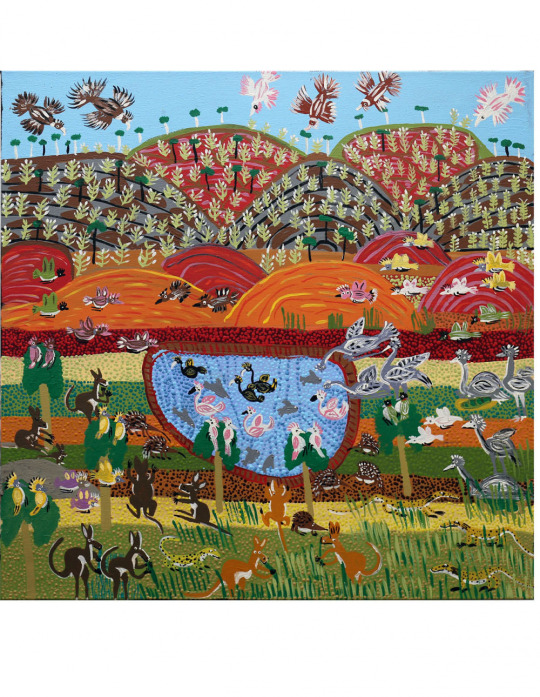
‘Waterhole inside Palm Valley’ by Joanne Napangardi Wheeler, 2021. Image – courtesy of the artist and Tangentyere Artists

‘Big Puta Puta After Rain’ by Nora Abbott, 2021. Image – courtesy of the artist and Tangentyere Artists
Tangentyere Art Centre
Established in 2005, Tangentyere Artists is an Aboriginal owned and run not-for-profit Art Centre in Mparntwe (Alice Springs). Tangentyere is an Arrernte word that means coming together, working together – which is exactly what they do.
Town Camp Artists communicate stories about their families, identity and lives in their artworks, and their practice aims to highlight the everyday experience of Aboriginal people in Central Australia. They are a hub for art activities across the 18 Town Camps of Mparntwe (Alice Springs), supporting emerging and established Town Camp artists through their studio, outreach program, gallery and online store
Artist April Spencer Napaltjarri says, ‘I love painting, telling stories with friends and family. I love coming here to Tangentyere Art Centre for a day of this, tea, people, canvas. Lots of people say hello! Hello! Happy people!’
Visit the Tangentyere Artists online store here and follow them on Instagram here.

Left to right: Tjulpus (birds) by Rochelle Ferguson, Tjilkamarta (echidna) by Lisa Armstrong, Papa (dog) by Katrina Tjitayi of Tjanpi Desert Weavers.
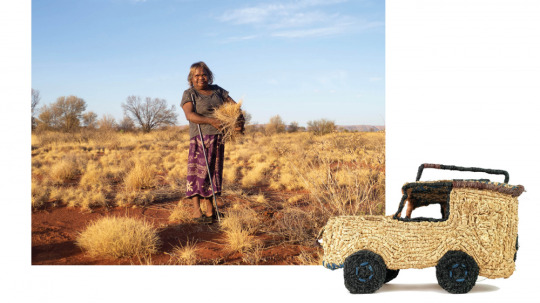
Left: Cynthia Burke from Warakurna (WA), 2019. Image by Jade Brockley Courtesy of Tjanpi Desert Weavers. Right: Umutja Toyota Come on Toyota! by Nellie Patterson of Tjanpi Desert Weavers.
Tjanpi Desert Weavers
Tjanpi Desert Weavers (Tjanpi meaning ‘wild grass’) is an award-winning, Indigenous governed and directed social enterprise of the Ngaanyatjarra, Pitjantjatjara and Yankunytjatjara Women’s Council (NPYWC). They empower over 400 Anangu minyma (Aboriginal women) to earn an income and remain in their communities on Country.
Building upon a long history of using natural fibres to make objects for ceremonial and daily use, Tjanpi artists create vibrant sculptures and baskets using native grasses, wool and raffia. In 2020, Tjanpi senior artist Tjunkaya Tapaya OAM won the Handcrafted Category of the TDF Design Awards!
Fibre artist Nyurpaya Kaika-Burton says, ‘Nowadays there are many different ways in which we transmit those ancient stories because we really hold these stories strong… this sculptural way is a whole new other way… we go out into the country to the actual place where these stories take place, where these dreaming tracks move through the country. We go there and we find materials. These sculptural pieces here are filled up with the story from the land.’
Visit the Tjanpi online store here and follow them on Instagram here.

Left: Nyapanyapa Yunupingu with her family. Right: Artist Nyapanyapa Yunupingu celebrates finishing her huge work Djulpan-Seven Sisters. Photo – courtesy of Buku-Larrŋgay Mulka Centre.
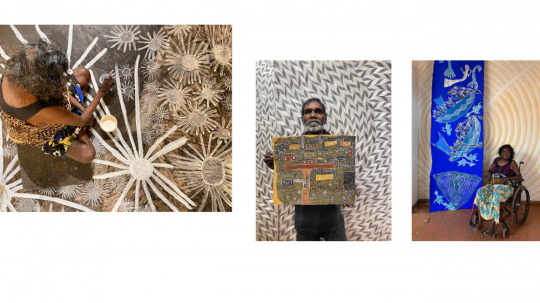
From left to right: Nyapanyapa Yunupingu working on a piece. Wanapa Munuŋgurr with his bark painting depicting his homeland community Wandawuy. Dhambit Munuŋgurr with part of her installation for the NGV Trienniel,
Buku-Larrnggay Mulka
Buku-Larrŋgay Mulka Centre is the Indigenous community controlled art centre of Northeast Arnhem Land. It is located in Yirrkala, a small Aboriginal community on the northeastern tip of the Top End of the Northern Territory, approximately 700km east of Darwin. The art centre has around 20 staff who are primarily Yolŋu, servicing Yirrkala and the approximately twenty-five homeland centres in a 200km radius.
The origins of the Buku-Larrŋgay Mulka Centre can be traced back to the 1960s with renowned artist Narritjin Maymuru, who is counted among the art centre’s main inspirations and founders. Buku-Larrŋgay Mulka Centre consists of two divisions; the Yirrkala Art Centre which represents Yolŋu artists exhibiting and selling contemporary art, and The Mulka Project which acts as a digital production studio and archiving centre incorporating the museum.
Buku-Larrŋgay means, ‘the feeling on your face as it is struck by the first rays of the sun’, and Mulka means, ‘a sacred but public ceremony.’
Visit the Buku-Larrnggay Mulka Centre online store here and follow them on Instagram here.
1 note
·
View note
Text
June 29-30 on the road to Mount Isa

After issues with van and car, we were a little nervous about taking yet another tough unsealed road, the Savanna Way (National Hwy 1) with its numerous river crossings which were reported to be deepish and flowing. Instead we opted to travel south on the Tablelands Hwy and on to Mt Isa along the Barkly Hwy. Are we getting more cautious in our old age?
You might be getting the impression that I am a bit of a sign addict. In truth I really love maps but signs? out on the road in the outback you ignore signs at your peril. It was less than a week since there had been flooding along this Hwy.


The road was a bit of or a lot of a shocker - very narrow and towards the southern end it undulates in all directions probably from the many trucks that travel the road. The Hwy changes its nature dramatically north to south. At the northern end we were driving beside the escarpment of the tablelands passing great stands of what I think were Snappy Gum with their ghostly pale trunks.

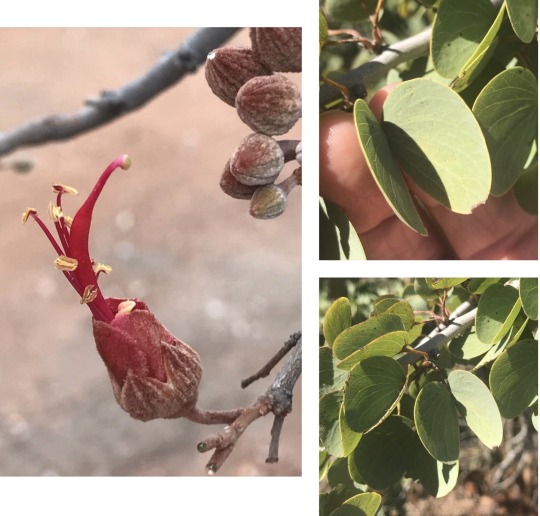
The roadside in places out on the plains were fringed with the delightful Bauhinia cunninghamii. It’s a semi-deciduous tree with leaves which look like little open books and flowers with perky red stamen waving out of rusty-velvety calyces. I kept my eye out for and stopped to hop out and go foraging for the flowers but no luck (this flower pic is from our last visit to the north). The trees are hosts to nests of native bees, but this time no flowers, no bees fortunately for me this time. The Aborigines sucked the nectar from the flowers and made a concoction out of roots and inner bark to use as skin antiseptic or use internally for fever or general illness.
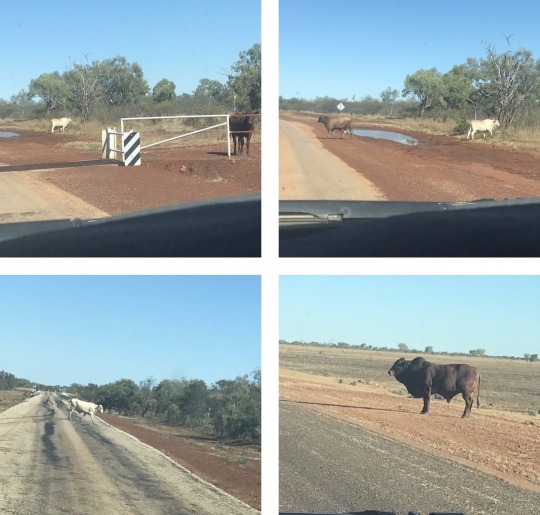
Find a puddle of water and you find cattle who amble across the road and turn to stare lazily at you; some are humongous. Gorgeous beasts.
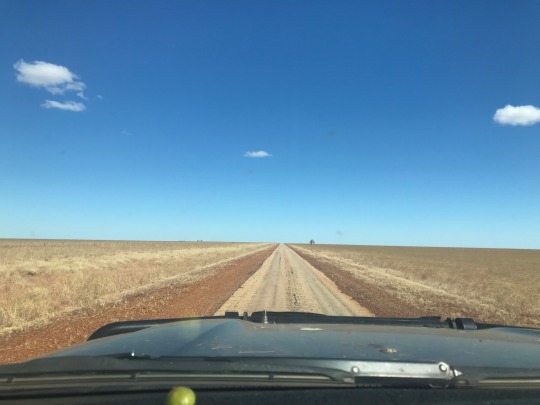
And then the horizon stretch around us flat and unbroken. I so love the plains! Vast unbroken stretches of grasslands where pratincoles flutter and dart alongside the road - or should! We saw none at all this time but we did see stately Jabirus leaping up and down then slowly lifting off like huge flapping aircraft.


We camped roadside that night ~10km north of the Barkly Hwy and Roadhouse which was packed out. Next morning we turned east onto the Hwy and hit the NT/Qld Border. But just before we reached the Border there was a road block heading into NT. All cars were being stopped! Good to be swimming against the tide.

A couple of hours later we were being swallowed up by hills as we approached Mount Isa. We were in among the ancient Selwyn Range containing rich payloads of copper, gold, lead and zinc - and hopefully some amethysts for me a little further SE at Kuridala! It’s a mineral-rich area. Fingers crossed.
0 notes
Text
Uranium mining operations to end, as Aboriginal people get back control of Jabiru, in historic legislation
Uranium mining operations to end, as Aboriginal people get back control of Jabiru, in historic legislation

Traditional owners regain control of Jabiru as historic land rights law passes Senate Natasha Emeck, NT News, 3 Sept 20
HISTORIC land rights legislation that will allow the traditional owners of Jabiru to regain control of their township has passed through the Senate.
Amendments to Aboriginal land rights laws passed through the upper house of federal parliament pm Thursday, returning the…
View On WordPress
0 notes
Text
Dreamings
The Dreamtime is a commonly used term for describing important features of Aboriginal spiritual beliefs and existence. It is not generally well understood by non-indigenous people.
Aboriginals believe that the Dreamtime was way back, at the very beginning. The land and the people were created by the Spirits. They made the rivers, streams, water holes the land, hills, rocks, plants and animals. It is believed that the Spirits gave them their hunting tools and each tribe its land, their totems and their Dreaming.
The Aboriginals believed that the entire world was made by their Ancestors way back in the very beginning of time, the Dreamtime. The Ancestors made everything.
The Ancestors made particular sites to show the Aboriginal people which places were to be sacred. The Aboriginals performed ritual ceremonies and customary songs near the sacred sites to please the Ancestral spirits and to keep themselves alive.
Distinct tribes had different philosophies and beliefs about the Ancestors who made the world. Some believed that the Ancestors were animal-spirits.
Others in parts of Arnhem Land in the Northern Territory believed the Ancestors were huge snakes. In other places the spirit who created the world were believed to be the Wanadjina.
Dreamtime is the foundation of Aboriginal religion and culture. It dates back some 65,000 years. It is the story of events that have happened, how the universe came to be, how human beings were created and how their Creator intended for humans to function within the world as they knew it.
Aboriginal people understood the Dreamtime as a beginning that never ended. They held the belief that the Dreamtime is a period on a continuum of past, present and future.

Aboriginal Spirituality
Part of listening, learning and living in respectful relationship with one another involves seeking to understand Indigenous spirituality, which is fundamental to many Indigenous people’s identity and worldview.
In an animistic world every thing is interconnected, people, plants and animals, landforms and celestial bodies are part of a larger reality. In this world, nothing is inanimate, everything is alive; animals, plants, and natural forces, all are energised by a spirit. As such, humans are on an equal footing with nature; are part of nature and are morally obligated to treat animals, plants and landforms with respect.
Booraboora budgang are the bringers of coy. If they dance in front of you, swinging their tails and screeching, then bad times are coming your way. It could be something significant or merely the warning of an argument.
The lair of the Buddawak burri bootyau is in the Nettle Cave. It is a night bird. Cootsa were told to be fearful of Buddawak burri bootya, “If you go into his territory he will take you away. His call or shriek, means death!”

Aboriginal Dreamtime Stories
The Emu and the Jabiru
Arnhem Land in the Northern Territory is fertile soil for Dreaming stories, including this one about a feisty family feud. After hunting some stingray, Gandji and his kids returned to camp to share the meat with Wurrpan and his family. However, Gandji stashed all the tastiest bits for himself, and Wurrpan wasn’t overly happy about that. When the two began to fight with spears and hot coals and rocks, Gandji flew away and turned into a jabiru (stork) and Wurrpan transformed into an emu.
Uluru
The Rock carries serious spiritual significance to the local Anangu people, and cultural ceremonies have taken place at the rock for more than 10,000 years. But this legend concerns visitors, not the traditional landowners. The Anangu have reported that they’re inundated with packages loaded with rocks that tourists have pilfered from Uluru then sent back to their rightful home, because the souvenirs have supposedly cursed their lives.
The Eaglehawk and the Crow
This Ngiyaampaa story from western New South Wales begins with the eaglehawk asking his neighbour the crow to mind his baby while he went hunting, but the crow didn’t have an especially good temperament for babysitting — he bludgeoned the child to death when it wouldn’t stop crying. Seeking revenge upon return, the eaglehawk chased the crow into the bush then set it alight to try and kill him; the crow managed to fly away, but not before it had been charred black.
The First Fire
This tale from the North Coast of New South Wales describes a tribe of people who lived in the sky world, and could light fires using nearby stars before anyone on Earth could spark a flame. A couple of adventurous sky world people popped down to Earth to hunt possums with their fire sticks, creating a huge blaze that various tribes could use to take fire back to their own camps.
0 notes
Photo

So, you’ve decided to take on Australia’s largest National Park, Kakadu. But where do you start when you have up to 20,000 square kilometres of floodplains, estuaries, waterfalls and stone country to explore? The place is so big, so bold and so beautiful, and is alive with Australian Aboriginal culture.
Understandably there are still some areas inaccessible to the public due to its cultural significance to the traditional landowners, but there are a couple of secret spots we can let you in on.
So here is a guide to get you on your way to packing your bag, loading the car or booking flights.
Noarlangie Rock at Kakadu National Park.
When to go
The top end of Australia doesn’t experience the usual four seasons. The wet season comes with the first crack of lighting on a late afternoon in November, and Kakadu goes from burnt orange to luscious green overnight.
When the wet season ramps up, so does the humidity. So a normal 35°C day starts to feel more like 45°C. It’s impossible to keep your shirt dry and there isn’t enough cold water in the world to satisfy your thirst. As beautiful as it is in the wet season, you need to know what you are doing in order to stay safe.
So with that, I suggest this hot tip, travel between May and July. At the start of the dry season, the waterfalls are still cascading heavily, the nights are cooler and the Barramundi are biting.
Walk to the top of Gunlom Falls to look out over the park.
Getting there
Kakadu National Park is 133km from Darwin and 149km from Katherine. If you are planning on flying, Darwin will be your best and cheapest option, accessible by direct flight from most capital cities.
As the Northern Territory’s capital city you’ll find plenty of options for 4WD/van/motorhome hire and accommodation options before venturing into Kakadu. Darwin is also a great place to stock up on food and fuel. Fuel prices are about 20c/L more expensive in the park.
Remember that you are about travel in to remote Australia. Although there is a good supermarket, medical centre and bank in Jabiru, near the centre of Kakadu NP, options are going to be limited.
The sunset over the Nourlangie rock lookout.
Choose your ride
It is not all bulldust and backroads like we had come to believe. So we were pleasantly surprised to be driving through the heart of the national park on the smooth surface of the Kakadu Highway. There is a good chunk of Kakadu that you can do in a standard 2WD, but if you want the full, unlimited experience we would definitely recommend a 4WD.
You do not necessarily need to be an experienced four-wheel-driver. You just need a high clearance vehicle that can make a shallow creek crossing or two and won’t rattle into smithereens on the dirt roads. Have you heard of corrugations? You will know all about these incessant bumps in the road as soon as you hit the turnoff to Jim Jim Falls, and they are relentless.
You’ll need a pass to access the wonders inside Kakadu NP.
Have you got your park pass?
You will need a park pass to access Kakadu National Park. You can buy your pass online, at the Katherine Visitor Centre or the Bowali Visitor Centre in Jabiru. Pass prices range from $12.50 for children and $25 for adults and last for up to 14 days.
Children under 4 are free and other discounts are available for families and concession card holders. 100% of this money goes right back into the park and supports the traditional landowners and general park upkeep.
Sandy Billabong is our top pick for camping in Kakadu.
Where to stay
If you can camp, camp. Kakadu offers 26 different campgrounds across the park, which range from fancy caravan parks to basic bush camping. So if you want a pool, hot showers and to treat yourself to dinner out, you can base yourself at the Cooinda Campground and Caravan Park.
But if you are like us and would prefer to light up a fire in a quiet corner of the park our top pick would be Sandy Billabong (it must be the sandy track and long drop toilets that deter a few people from getting in here). All of the big hitters like Gunlom, Jim Jim Falls and Maguk have a campground nearby so that you can really make the most of these special places. Camping fees depend on the facilities available and you will find some of the more remote sites are free of charge.
If you were not planning on camping at all, fear not, you have 7 hotels/lodges/resorts with varying degrees of luxury to choose from.
A campfire dinner at our campsite at Sandy Billabong.
What to bring
An alarm clock. There is a reason this place gets busy, so if you want to beat the crowds and enjoy some time to yourself at the top of Jim Jim Falls, set your alarm. Getting up early is also the best way to beat the heat. Speaking of heat, here are some things you will need to have with you in order to prevent heat exposure.
Water, minimum 1L per hour of activity, or 4L per day
Lightweight, long sleeved shirts
Sunscreen
You’ll need sun basics such as hats and a daypack for exploring the park.
Some other things you will also need to include;
Mosquito repellent
Hiking boots
Backpack for day trips which must always contain water, snacks and a basic first aid kit
Camera
Swimmers
Towel
Park pass
National Park map
With so many opportunities to enjoy the water, swimmers and a towel are a must.
Our top 5
1. Maguk
Mother Nature did some amazing work on this playground. Blue water, glowing orange rocks and waterfalls that lead into more waterfalls. Read a bit more about it below in Secret Spots.
2. Jim Jim Falls
This one is a tour bus favourite so timing is everything. The earlier the better, or you might get lucky around 3 pm when they start loading their customers back on the bus. After making the rock scramble to the first beach on the right-hand side, we would suggest holding your backpack above your head and swimming around to the second beach to find a bit of space that is all yours. Once again, check out Secret Spots for a hidden gem close by.
Swimming through the pristine waters of Maguk.
3. Ubirr
If you are looking for an education on Australian Aboriginal history this is the place. Once a great meeting place and educational hub, the area is covered in densely intricate rock art that dates back 3000 years and tells a vivid story of life in the area. There is a Ranger-guided walk through the site that really gives you an understanding of the Aboriginal culture that is alive in Kakadu.
Ubirr is also an amazing place to watch the sunset, with floodplains on one side and stone country on the other. Give it time and watch the colours change over the landscape and the shadows lengthen across stony escarpments.
4. Yellow Water River Cruise
Ever thought of feeding your kids to the crocs? this would be the place… don’t though. The crocodiles here are brazen and about as big and bold as Kakadu itself. It is not only crocodiles you’ll see, but Asian Buffalo and wild horses on the banks.
There are plenty of Barramundi and Saratoga if you are going to wet a line. And the most beautiful water lilies stand proudly along the edges of Yellow Water.
A saltie we spotted on the Yellow Water Cruise.
5. Twin Falls
An immense waterfall that is open for a limited time each year due to high waters and a shuttle boat crossing. It would be worth looking into a helicopter flight in order to see this beauty in full flow if you can’t gain access
Secret Spots
There are a couple of places that just don’t get much hype. Or they get a lot of hype but some crucial information is missing, for example, Barrk Marlam.
Barrk Marlam
You have heard of Jim Jim Falls (I’ve definitely mentioned it a few times), but have you heard of Barrk Marlam? Well, it is one of our absolute highlights and not well marked. From the car park at Jim Jim Falls you follow the path to the falls for about 200m before turning off (there is a small sign) to the right across the creek.
The hike requires you to follow the pink ribbons hung in the trees to guide you to the top of Jim Jim Falls. Now it says that this hike is 6km return, but it is so intense it feels like twice that distance. At the top, you will be rewarded with spectacular views and private swimming holes.
Barrk Marlam is a challenging bushwalk, but well worth the hike.
Maguk’s infinity pool
Maguk’s infinity pool, we would not have noticed this sneaky spot if it wasn’t for a tiny little head that poked over the falls when we were swimming in the main gorge. To get to Maguk’s infinity pool you will need to stay on the left-hand side of the creek when the arrows tell you to cross. Look straight ahead and you’ll see the making of a well-worn path, follow it.
This walk is quite a bit easier than Barrk Marlam and just as rewarding. Be sure to take some goggles to see this gorge below the surface. If you are brave you probably won’t hesitate to swim through one of the underwater rock tunnels.
Motor Car Falls
Motor Car Falls is accessed via part of the Yirmikmik trails. 3.75km of fairly level ground will take you from a dry and dusty service road into a tropical oasis. Drape yourself over a giant boulder with sun rays pouring between prehistoric-looking trees, and then float on cool waters beneath zebra printed rocks. You are almost guaranteed to get this place to yourself any time of day.
The infinity pool at Maguk is not to be missed.
The Rockhole (Moline)
Lastly, a secret local’s hotspot, The Rockhole (Moline). Not marked on the map or signposted from the road, this one has been saved for some small tour group exclusivity. Time to put it on the map. As you are heading south down the Kakadu Highway and coming down the range, at the bottom of the hill is a right-hand turn off with what looks like a green postbox on the corner.
The road in is rocky and can be narrow in sections, with only a small turning area at the end (take care if towing). Just 200m from the carpark is a pool with natural rocky seats along its sides, a waterfall that cascades down a narrow gorge and into the water, where curious turtles pop up to check you out.
The Rockhole Moline is a spot loved by the locals.
Croc safety
The Top End is alive with crocodiles, both saltwater and freshwater. Although you can often safely swim in the same pool as a “freshie”, “salties” will not allow that same kind of luxury.
We’ve done our fair share of travel along the top end of Australia and shared the water with some big crocs on fishing trips, but we have never met crocs like the ones in Kakadu. Kakadu is the first place we have had a crocodile come in direct pursuit of our boat. These guys are no joke. Obey signs and check with Rangers on where it is safe to swim. The changing water levels in Kakadu mean that crocs can get in anywhere.
When picking a camp spot, stay at least 50m from the water’s edge and always leave at least 5m between you and the water when walking or fishing. Respect these prehistoric beasts, there’s a reason they have been around longer than us.
Make sure you obey signs of where you can swim.
That’s all from us
We hope that this has given you enough information to confidently book your flight, hire a car or drive straight in there on part of your Australia trip.
Be sure to check in at the Warradjan Cultural Centre or any of the visitor’s centres to pick up your park maps and activity timetables.
You’ll find lots of hikes, Ranger-guided activities, and birdwatching, and enough places to fish to keep you fed. It’s a Kaka-DO from us!
What have your trips to the top end been like?
The post Guide to Visiting Kakadu in the Northern Territory appeared first on Snowys Blog.
0 notes
Text
Departing from Daly Waters was nor easy as it is such a great place to just sit around but we did, after filling the van with water. The drive through to Mataranka was short and we took the extra time for a swim in the thermal springs. Very very nice. Again we elected to stay and extra night it was so restive. The bats here at night come out in their thousands and during the night the sound they were making was huge. After two nights we pushed through to Kakadu via Pine Creek. It was slow and hot and we elected to stay just outside of Jabiru at a local camp ground. Great place until night fell when we found out we were in a pocket surrounded by a creek. Through out the night we continued to hear what we believe to be crocodiles calling to each other. Sure made the walk to the toilet very brisk in the darkness of night. Hahha We took the chance to visit the aboriginal drawing at Ubirr and watch the sunset Another thing everyone should do at least once. The next day we decided to do some walks and visit some views and billabongs. The first walk we attempted and I mean attempted was Mirrai lookout. Supposed to be a 1.2 kilometre walk but no one mentioned it was straight up. We did not make it and drove through to see the Sandy billabong and then on to the Burrungkuy drawings and do the walk to the view from there. From our opinion was probably better then Mirrai anyways. Hahaha Took the time to visit Jabiru township itself and was most impressed with the town, given it has everything one needs as to costs very moderate. The highlight of our visit here was the early morning "Yellow Waters" boat ride. Saw amazing birds and lots of very big crocodiles. The guide was exceptional and spoke well about how industry (mines) and nature can co-exist if everyone respects the other. Very impressive. We had decided to leave straight after the boat ride and in hind site should have stayed another night. The drive into Darwin was very hard given how awake we had been during the night (crocs calling) and the early start to see the sunrise over the water. Once in Darwin region we booked into the Boomerang Caravan park about 30 kilometres outside of Darwin city. It is old but has a pool and is next to a pub which has a happy hour with very cold beer. Darwin has changed so much since we were last here with housing and development everywhere. It is truly a city with a great road network that Brisbane would be very proud of Today sitting around the van after doing some shopping enjoying the cool breeze that blows through the park. It is very hot but what else would one expect in Darwin.
1 note
·
View note
Text

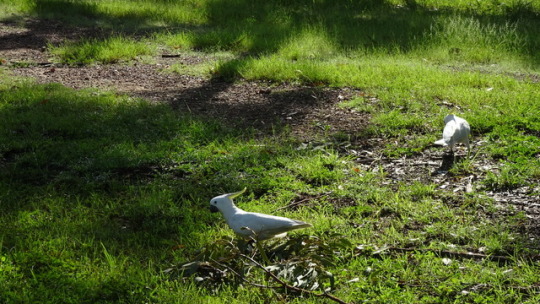
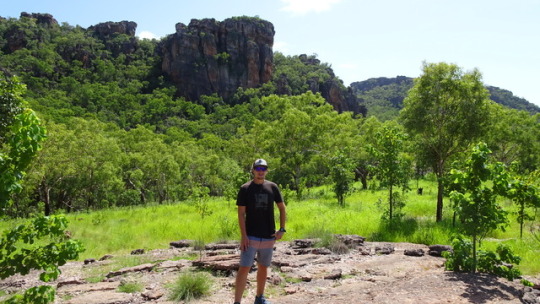




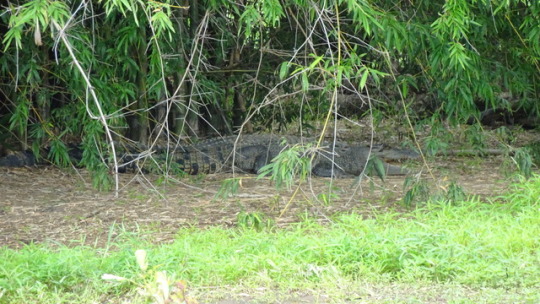


Outback-Trip Darwin - Alice Springs
1. Etappe: Darwin und Kakadu-Nationalpark
Als wir in Darwin aus dem Flughafen treten ist es halb 2 Uhr morgens (da der spät angesetzte Flug noch Verspätung hatte.. 😉). Wir sind daher überrascht über die schwüle Hitze, die uns selbst zu dieser späten Stunde entgegenschlägt. Der Taxifahrer lässt uns dann auch noch durch die Blume wissen, dass er sich nicht länger als nötig in Darwin aufhalten würde, dass es generell ein ganz furchtbarer Ort zum Leben ist und dass er selbst nur darauf wartet, von hier wegzukommen.. Wir wollen erstmal nur ins Bett, bevor wir uns selbst ein Bild davon machen können.
Als wir uns am nächsten Tag zu einem ersten Spaziergang durch das Stadtzentrum aufmachen, müssen wir den Aussagen des Taxifahrers ein kleines Fünkchen Wahrheit zugestehen: Zumindest klimatechnisch erscheint uns Darwin (um diese Jahreszeit) eine Herausforderung! Dabei sind es weniger die 39° Celsius als die hohe Luftfeuchtigkeit, die uns zu schaffen machen. Darwin ist nicht nur die nördlichste sondern auch die einzige größere Stadt Australiens, die bereits in der tropischen Klimazone liegt. Gerade ist "wet season"/Regenzeit, weshalb sich das schwüle Wetter noch verstärkt - um diese Zeit kommen nur wenige Touristen (vielleicht nicht gaaanz unberechtigt?!). Von Sightseeing kann jedenfalls keine Rede sein, vielmehr retten wir uns von Schatten zu Schatten.. Und wundern uns daher auch wenig über die menschenleeren Straßen.
Nicht, dass Darwin selber viel zum Sightseeing hergeben würde, wie wir feststellen: Mit 120.000 Einwohnern ist es eine nüchterne, modern angelegte Stadt mit einer kurzen Fußgängerzone, einigen am Abend gut gefüllten Bars und Restaurants (Darwin rühmt sich vor allem für sein Nachtleben) und ein paar Einkaufszentren.
Das Northern Territory ist der Bundesstaat Australiens, in dem die Aborigines inzwischen wieder große Gebiete besitzen und oft selbst verwalten. In Darwin zeichnet sich zunächst aber ein trauriges Bild: Es ist bedrückend zu sehen, wie viele von ihnen schon vormittags in den Parks, Gehsteigen oder vor dem Supermarkt im Schatten sitzen, viele betrunken oder mit Alkoholflaschen in der Hand. Es ist ein schwieriges Thema, mit dem wir noch öfter konfrontiert werden und über das wir noch viel nachdenken..
Aber genug von Darwin, hauptsächlich soll uns die Stadt ja als Augangspunkt für unseren "Roadtrip" durch das australische Outback dienen. Der Stuart-Highway durchzieht Australien von Darwin im Norden bis nach Adelaide ganz im Süden. Wir wollen ihm bis nach Alice Springs im Zentrum des Landes folgen und von dort aus den Uluru und dessen Umgebung erkunden. Damit liegen über 4.000 Kilometer in den nächsten zwei Wochen vor uns - wir haben uns dafür einen Campervan gemietet, der uns hoffentlich gute Dienste leisten wird.
Unser erster Abstecher führt uns in den Kakadu-Nationalpark: In der Regenzeit sind hier nicht nur große Gebiete sondern auch die Straßen unter Wasser. Jetzt gegen Ende der "wet season" sind zumindest die beiden Hauptstraßen bereits befahrbar - trotzdem muss man sich den Wetterbericht genau anschauen: große Niederschlagsmengen können die Straßenverhältnisse schnell ändern (was wir bestätigt sehen, als wir die teilweise nur knapp unterhalb der Straße liegenden Wasserstände sehen..) und wir wollen auch wieder aus dem Park herauskommen 😅
Es ist eine wunderschöne Fahrt entlang des Arnhelm- Highway: Durch den vielen Regen explodiert die Natur geradezu in grellem Grün. Meterhohes Gras wächst zwischen den Bäumen, große Flächen stehen unter Wasser und sind in sattgrüne "Wetlands" verwandelt, auf denen Wasserpflanzen und Seerosen wachsen. Der East Alligator River tritt weit über seine Ufer und hunderte "Magpie-Gänse" tummeln sich auf dem Wasser und auf den Rastplätzen springen Wallabies aufgeregt davon, als wir uns nähern.
Unsere erste Nacht im Campervan wird aber ziemlich unbequem: Mücken und Fliegen machen es unmöglich draußen zu sitzen, auch als es dunkel wird scheint es nicht abzukühlen und durch die regelmäßigen Blitze in der Ferne wird es alle 10 Sekunden taghell. In der Hauptsaison werden die Krokodile von den für Touristen zugänglichen Gebieten entfernt - um diese Zeit sind sie durch die Wasserstände unmöglich zu kontrollieren. Auf dem menschenleeren Parkplatz entfernen wir uns daher in der Dunkelheit auch lieber nicht allzuweit weg von unserem Gefährt..
Am nächsten Morgen geht es etwas übermüdet weiter nach Jabiru, der einzigen größeren Ortschaft im Nationalpark. Außer den Arbeitern der nahen Uran-Miene scheint der Ort vollkommen verlassen, Hotels, Ferienanlagen und Campingplätze sind noch geschlossen. Hinter Jabiru grenzt "Arnhem-Land" an den Kakadu-Nationalpark: es ist ein knapp 100.000 Quadratkilometer großes Siedlungsgebiet der Aborigines. Um dorthin zu fahren, braucht es nicht nur ein Auto mit Allradantrieb, da es nur unbefestigte Straßen gibt, sondern auch Vorab-Genehmigungen für die Durchfahrt - das ist aber sowieso erst wieder in der trockenen Jahreszeit möglich.
Wir fahren weiter nach Nourlangie, wo wir auf einer kurzen Wanderung uralte Felsmalereien der Aborigines betrachten (die man aber nicht fotografieren soll). Bei der Bootsfahrt auf dem Yellow River bestaunen wir nicht nur die vielen Vögel sondern sind beim Anblick der gut getarnten Salzwasserkrokodile (die bis zu 6 Meter lang werden) auch froh, so vorsichtig gewesen zu sein.
Am Abend ist uns am Campingplatz in Pine Creek dank Pool zum ersten Mal seit zwei Tagen nicht mehr (so) heiß.
0 notes
Photo

Can't wait to see this film 😍🤗😍🤗😍🤗 #SimonBaker #HighGround #HighGroundFilm #HighGroundmovie #TheHighGround #callanmulvey #jackthompson #Action #Thriller #aboriginals #arnhemland #kakadu #kakadunationalpark #madeinaustralia #northerntheretory #jabiru #bountyhunter #australia #movie #film #makingof #bts #thatsawrap #excited #mustache #screenaustralia Source : https://iview.abc.net.au/show/australian-story/series/2019 https://www.instagram.com/p/BuB5Ne9DrO-/?utm_source=ig_tumblr_share&igshid=4vhnta345vcq
#simonbaker#highground#highgroundfilm#highgroundmovie#thehighground#callanmulvey#jackthompson#action#thriller#aboriginals#arnhemland#kakadu#kakadunationalpark#madeinaustralia#northerntheretory#jabiru#bountyhunter#australia#movie#film#makingof#bts#thatsawrap#excited#mustache#screenaustralia
8 notes
·
View notes
Text
Days 24 and 25
We have a routine of sorts most days when we are travelling in the van. We are usually awake before 7am, but late to rise after knocking off a few Killer Sudokus each morning – if we don’t have an early start planned. If we have some sort of excursion planned, we normally get breakfast over and all the chores done and get away by about 10am. Very often we don���t return until 5 or 6pm - just in time for our Happy Hour (that often exceeds the prescribed duration). Most nights we roll into bed soon after (a usually latish) dinner and watch a video. We are almost finished the complete ‘Vera’ series at present (and our current book of Sudokus!) so will have to start something new when we return from our Venture North Tour. It is a life I think we could enjoy for quite a while without getting overly-bored.
Saturday was spent totally in the caravan park – we didn’t go out at all. We did all the housework – washing and ironing (we don’t iron – all our clothes are iron-resistant), sweeping, cleaning, dishes, tidying – and packing for our Cobourg Peninsula adventure next week. We will be completely off the grid all week – no phone or internet – and no blog until after we get back. We spent a lot of the day updating our blogs and catching up on emails and other paperwork – pausing only infrequently (not too infrequently) to indulge our appetites for food and drink.
Sunday, we were up reasonably early. We went on the Red Bus – the Hop On Hop Off service that does a big loop past most of the special attractions around Darwin. We usually look for these buses whenever we visit big cities (Sydney, Moscow, Barcelona…..). They are a good way to get an overview of the city and they help us decide what attractions need more time. We went down to the Museum stop to start the tour today because that is apparently the only convenient all-day free parking and then did the 70-minute circuit arriving back at the Museum in time for a well-earned lunch at their Cornucopia Café. The Museum and Art Gallery itself is really interesting, with specific areas for a range of different displays – one gallery for each of contemporary Australian art, indigenous art, a recent student art competition (some really good stuff!), Cyclone Tracy (3-4 rooms), an excellent Natural History area covering some evolutionary transitions from earliest pre-historic times until today, a really great maritime display of a couple of dozen marine craft, many with historical significance for northern Australia – and the usual kids Discovery Area, shop, Café and so on.
It was hot and we were tired after walking around the museum and galleries, so after our lunch, instead of hopping back on the bus, we just headed for home, doing a little last minute grocery shopping for the coming week’s trip on the way. We also did another little detour before we arrived home – we went to the end of the road past the caravan park down to the Lee Point Marine Reserve and then around to Buffalo Creek at the end of another road a couple of kilometres further along the coast. I spied a few birds there and we did a short, hot walk to a bird hide. (We saw nothing there so I concluded that as a bird hide, it was very effective in hiding birds.) I had seen some waders a bit further along, but Heather needed to get back to the van so I dropped her back and returned to Buffalo Creek to suss out the waders a bit more closely. They weren’t anything we hadn’t seen before, but it added three more species to our NT trip list.
We are really looking forward to this coming week. We get picked up at 6.45am tomorrow and will spend most of the day in the Kakadu NP, including a birding cruise at Corroboree Falls and staying at Jabiru overnight. Then it is off to the extreme north of Arnhem Land and the Cobourg Peninsula. It sounds like a lot of fun, a real outback adventure without too much privation – mozzie-proof tents, outdoor eating, catching some of our own tucker (mud crabs, fish, etc.) and learning more about aboriginal culture and their traditional way of life. There are only 6 of us on the tour and it is done in a 7-seater Landcruiser 200, similar to ours, but one step up the luxury ladder – the Sahara.
We will be about as easy to contact as if we were on Mars during the week, but we get back to Darwin on Friday evening so maybe I will have some stories to tell I my next blog-post or two in about a weeks’ time.
Can you wait that long? Who knows, now that I have figured out how, I might even include a photo or two to stimulate your senses.
2 notes
·
View notes
Text
Top 5 Must-Visit Destinations for Avid Naturalists in Australia
Located between the Indian and Pacific Oceans, Australia is the world’s largest island. Home to some of the most unique creatures and diverse species, Australia is a paradise for nature lovers. If you, too, are a nature lover who enjoys venturing into the wild to get a glimpse of some of the rare species of animals or birds, you must visit Australia at least once in your lifetime. Apart from the kangaroos, the diverse varieties of migratory and resident birds in Australia will leave you in awe. When you book Australia tour packages, ensure that your travel itinerary includes some of the famous National Parks for thrilling wildlife experiences. To help, we list the top five destinations that nature lovers need to visit on their trip to Australia. Read on.
Pebbly Beach, Murramarang National Park
If you want to see some friendly kangaroos hopping around the beach, head to the Murramarang National Park. Situated 200 km south of Sydney, Murramarang National Park is a renowned spot for spotting wild kangaroos. You can see hundreds of wild kangaroos hanging around tents and cabins like well-trained pets. The magnificent views, cool morning breeze and crowd of kangaroos wandering around make it worth to visit Pebbly Beach.
Kakadu National Park in the Northern Territory
Kakadu National Park, an archaeological and ethnological reserve, is the only place where you can watch crocodiles and aboriginal rock art. The aborigines lived in the region for around 40,000 years and created rock art in approximately 5,000 places. The National Park, located in the Northern Territory, is renowned for its diverse terrain, flora and fauna. The Alligator River is situated within the boundaries of the park and you can spot some giant crocodiles and kangaroos, here.
Seal Bay Conservation Park, Kangaroo Island
Your visit to Australia is incomplete without visiting the Seal Bay Conservation Park, Kangaroo Island. The seaside park is a beautiful place to view the large colony of sea lions. Watch the sea lions play on the beach, swim in the sea, nurse their young ones and rest in the sun. The Park also has an environment-friendly visitor center powered by solar energy which has interactive displays to help visitors learn about the history of sea lions.
Ningaloo Reef, WA
Located on the West Australian coastline, the Ningaloo Reef is a place where you can watch some majestic creatures. The world’s largest reef is home to turtles, whale sharks, manta rays, tropical fish and humpback whales. There are approximately 500 varieties of tropical fish, but it’s the whale sharks that will get your heart racing. Swim with the whale sharks and humpback whales, snorkel at the Turquoise Bay, and visit the town of the emus on your trip to the Ningaloo Reef.
Mary River, Near Kakadu National Park
If you are a nature lover, you can’t miss out visiting Mary River, located on the east of Darwin. The destination is known for its diverse varieties of wildlife, birds and fish. The Fogg Dam Conservation Reserve has around 250 species of birds that flock during the dry season. You can spot birds such as Jabiru, ibis, brolga, pygmy geese and jacana feeding among the Lotus lilies. You can also get a glimpse of jumping crocodiles that emerge from water to grab the bait of riverboats.
Last Few Words
Australia, the world’s biggest coral reef, is renowned for its diverse creatures. The rich flora and fauna make it an ideal vacation destination, especially for nature lovers. Apart from kangaroos, you can also get a glimpse of some of the rare creatures that will make your trip memorable. When you book a customized tour to Australia from Mumbai or any other part in India, make sure that it includes at least one or two of the five National Parks discussed in this post.
0 notes